Sonim Technologies L11V011AA LTE Smartphone User Manual
Sonim Technologies, Inc. LTE Smartphone
User manual

1
USER
GUIDE
SONIM XP6
English
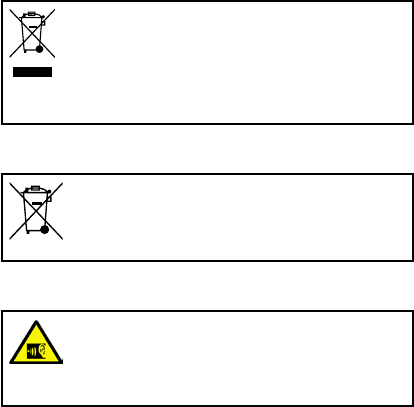
2
Copyright © 2014 Sonim Technologies, Inc.
SONIM and the Sonim logo are trademarks of Sonim
Technologies, Inc. Other company and product names
may be trademarks or registered trade-marks of the
respective owners with whom they are associated.
Disposal of Old Electrical and Electronic Equipment
The symbol of the crossed-out wheeled
bin indicates that within the countries in
the European Union, this product, and any
enhancements marked with this symbol,
can not be disposed as unsorted waste
but must be taken to separate collection at
their end- of-life.
Disposal of Battery
Please check local regulations for disposal
of batteries. The battery should never be
placed in municipal waste. Use a battery
disposal facility if available.
Guideline for Headphone and Earphone
To prevent possible hearing damage,
please do not listen at high volume levels
for long periods.

3
Contents
General Information———————— 7
Phone Models Covered
Network Services
Sonim Support Information
Use the Guide Effectively
Safety Guidelines———————— 9
SAR Information
Avoid Short Circuit
Avoid High Temperatures
Battery Disposal
Personal Medical Devices
Child Safety
Emergency Calls
Battery usage Guidelines———————— 14
Battery Usage
Charging the Battery
Verifying and Optimizing Battery Usage
Extend the life of your battery
Getting Started———————— 16
What Is In the Box ?
Phone Specications
Your SIM Card
Inserting the SIM Card
Your Sonim XP6———————— 18
Switching On
Setting Up Your Phone
Need for a Google Account
Touch and Type Operations
Managing Home Screen
Home Screen Indicators
Phone Operations Without SIM Card
Setting up and Using Lock Screen
Changing the Wall paper
Taking a Screenshot
Keypad Functions
Managing Phone Settings———————— 27
Time and Date Settings
Language and Input Settings
Mouse/Pointer Settings
Power Saving Settings
Connecting a Wirelss Display Device
Connecting a PC Using USB Connection
Viewing Device Details
Managing Memory Utilized by Applications
Optimizing Memory Usage
Managing Wireless and Network
Settings———————— 31
Connecting to Wi-Fi Network
Connecting to Bluetooth Devices
Optimizing Data Usage
Activating Airplane Mode
Setting Up Tethering & portable hotspot
Setting Up Wi-Fi Hotspot
Activating Bluetooth Tethering
Managing Mobile Network
Managing Cell Broadcasts
Managing Phone Security Settings———————— 35
About Android Security
Managing Security Settings
Locking your Screen
Encrypting Phone Data
Locking Your SIM Card
Managing Credential Certicates
Protecting your Phone from Harmful Applications
Managing Personal, Account and System
Settings———————— 37
Location Access
Backup and Restore Data
Managing Accounts
Syncing Your Account

4
Managing Contacts———————— 40
Add a New Contact
View the Contact Details
Sending a Message from Contacts
Dialing a Number from Contacts
Editing the Contact Details
Importing SIM Card Contacts to Phone
Exporting Phone Contacts to SIM Card
Exporting Phone Contacts to Storage
Creating Caller Groups
Syncing Your Phone Contacts with Google Account
Managing Contact Settings
Managing Phonebook Settings
Searching Contacts
Deleting a Contact
Managing Calls———————— 43
Making a Call
Dialing a Number via People
Answering an Incoming Call
Adding a Contact From Phone Screen
Viewing All Contacts from Phone Screen
Viewing Call History
Deleting Call History
Deleting Frequently Called Contacts List
Managing Call Settings
Changing Ringtones
Activating Touch Tones
Activating Vibrate Mode
Editing Quick Responses
Managing Fixed Dial Numbers
Monitoring Incoming and Outgoing Calls
Turn on proximity sensor
Setting TTY Mode
Call Forwarding
SIP Accounts
Use Internet Calling
Optimizing Power During a Call
Sending Messages———————— 48
Sending SMS/MMS Message
Managing Message Settings
Deleting Messages
Cell Broadcast Messages
Text Entry Options
Installing and Using Android
Applications———————— 51
Google Play Store
Downloading Android Applications and Media Files
Accessing GMail
Camera
Calendar
Alarm
Clock
Calculator
Sound Recorder
Music Player
End User License Agreement———————— 55
Our Warranty
Comprehensive 3 Year Warranty
Our Warranty
What We Will Do
Phone Care
Conditions
Federal Communication Commission Interference
(FCC) Statement———————— 58
FCC Statement
IC Statement
FOR PORTABLE DEVICE USAGE (<20cm from body/
SAR needed)
FOR MOBILE DEVICE USAGE (>20cm/low power)
Règlement FCC———————— 60
Règlement FCC
Règlement IC
Contents
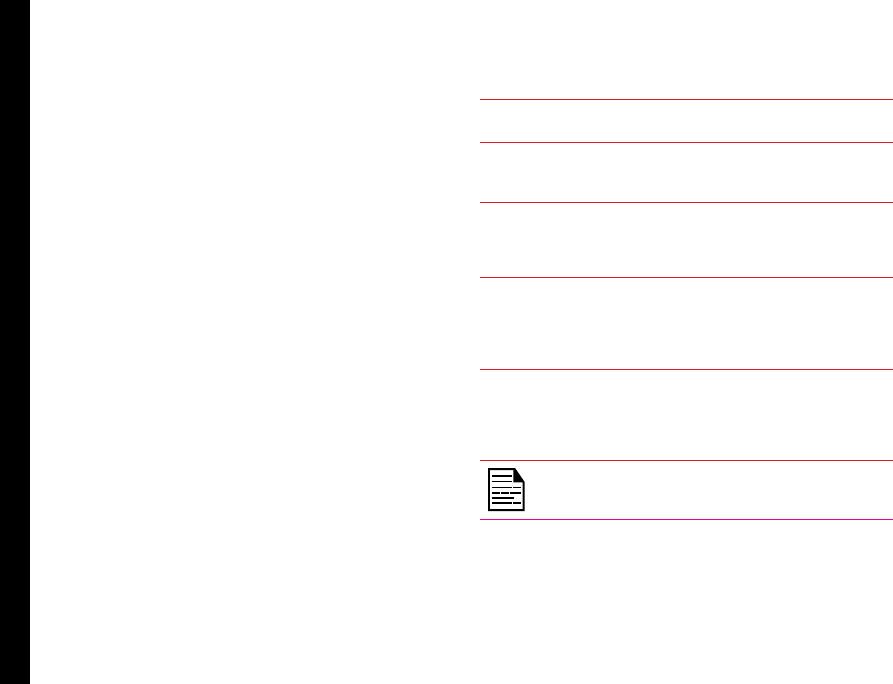
7
Congratulations on the purchase of a Sonim XP6 mobile
phone. This phone is a GSM/GPRS/EDGE/UMTS/LTE
enabled handset with quad-band capabilities and has an
intuitive, feature-rich user interface, which allows you to
make the best use of the offered functions.
Phone Models Covered
This user guide only covers Sonim XP6 phone models
XP6700. The model name can be read on the phone label
under the battery.
These models utilizes the following 3G RF bands:
• GSM 850 /900/1800/1900
• UMTS Band II/V /I Global/VIII
• UMTS 850/1900/2100/900
• LTE Band 4/17/2/5/7/3/1
Network Services
These are additional services that you can avail through
your network service provider. To make the best of these
services, you must subscribe to them through your
service provider and obtain instructions for their use from
your service provider.
Sonim Support Information
For additional product and support information,
visit www.sonimtech.com.
Use the Guide Effectively
Familiarize yourself with the terminology and symbols
used in the guide to help you use your phone effectively.
HOME
SCREEN This is the screen displayed when the
phone is in idle condition.
TOUCH &
HOLD Touch and hold an item on the screen
by touching it and not lifting your nger
until an action occurs.
DRAG Touch and hold an item for a moment
and then, without lifting your nger,
move your nger on the screen until
you reach the target position.
SWIPE OR
SLIDE Quickly move your nger across the
surface of the screen, without pausing
when you rst touch. For example, you
can slide a home screen left or right to
view the other home screens.
DOUBLE TAP Tap quickly twice on a webpage, map
or other screen to zoom. For example,
double-tap a webpage in Browser to
zoom in, and double-tap again to zoom
out.
Signies a Note.
Options Commonly Used across Menu Items
The following are common actions used across various
menu items:
General Information

8
BACK Displays the previous screen. Use
the Left Selection Key to perform
this function.
OK Conrms an action. Use the
Center key to perform this
function.
BACK KEY Use this key to display the
previous screen.
HOME Moves the current working
application to the recent
applications list/background and
displays home screen
RECENT Displays the thumbnails of the
applications that you have worked
on recently. To remove any
application from this list, swipe the
application to left or right.
General Information

9
Please read and understand the following safety guidelines before you use the phone. These guidelines provide details
to enable you to operate your phone safely and conform to any legal requirements regarding the use of cellular phones.
Do not to use the phone at a refuelling point. Observe restrictions when using radio equipment at
fuel depots, chemical plants or where blasting operations are in progress.
Electrical interference may obstruct the use of your phone. Observe restrictions in hospitals and
near medical equipment.
Switch off your cellular phone when in an aircraft. Wireless phones can cause interference or danger
to an aircraft. In an aircraft, the phone can be used in flight mode.
Do not expose the battery to high temperatures (in excess of 55°C).
Adhere to road safety laws. Do not hold/use a phone while you are driving; find a safe place to stop
first. Use hands-free microphone while you are driving.
Avoid using the phone in close proximity to personal medical devices, such as pacemakers and
hearing aids.
Use only Sonim XP6 approved charging equipment to charge your phone and avoid damage to your
phone.
Safety Guidelines

10
The symbol of the crossed-out wheeled bin indicates that this product, and any enhancements
marked with this symbol, can not be disposed as unsorted waste but must be taken to separate
collection at their end-of-life.
Ensure that only qualied personnel install or repair your phone.
The Sonim XP6 is water-proof and can be submerged to 2 metres for 1 hour.
• Ensure to properly close the rubber cover of the charging connector and audio connector, to
avoid deposits of water drops on these connectors, when the phone is immersed in water.
• Water droplets may condense under the display cover if the phone is immersed in water with
signicant drop in temperature. This does not indicate water leakage. The droplets disappear
at room temperature.
The Sonim XP6 is dust-resistant, rugged and shock-resistant. However, it is not dust-proof or
unbreakable if subjected to overwhelming impact. For best results and long product life, one should
protect the Sonim XP6 from salt water, dust and strong impacts.
Safety Guidelines

11
SAR Information
The Sonim XP6 has been certified in compliance with
the Government’s requirements for exposure to Radio
Waves.
When communicating over the wireless network, the
mobile phone emits via the radio frequency waves low
levels of radio energy. The Specic Absorption Rate, or
SAR, is the amount of RF energy absorbed by the body
while using the phone and is expressed in watts/kilogram
(W/kg).
Governments around the world have adopted
comprehensive international safety guidelines, developed
by scientic organizations, for example, ICNIRP
(International Commission on Non-Ionizing Radiation
Protection) and IEEE (The Institute of Electrical and
Electronics Engineers Inc.). These guidelines establish
permitted levels of radio wave exposure for the general
population.
Tests for SAR are conducted using standardized methods
with the phone transmitting at its highest certied power
level in all used frequency bands.
SAR Data Information for residents in the United
States and Canada
The limit recommended by ICNIRP is 1.6 W/kg averaged
over one (1) gram of tissue.
The highest SAR value for the Sonim XP6700 phones
when tested by Sonim for use:
• By the ear is 0.93 W/1g.
• Worn on the body is 1.29 W/1g provided that the
phone is used with a non-metallic accessory with
the handset at least 1 cm from the body, or with the
original Sonim accessory intended for this phone
and worn on the body.
HAC Rating
The FCC has created a rating system for cellular phones
regarding their HAC-related performance. This rating
helps consumers with hearing disabilities to nd phones
that work well with their hearing aid devices. The HAC
rating and measurement procedure are described
in the American National Standards Institute (ANSI)
C63.19:2011.
ANSI C63.19 contains two rating standards: an “M” rating
from 1 to 4 for hearing aids operating in microphone
mode, and a “T” rating from 1 to 4 for hearing aids
operating in telecoil mode.
M-Rating stands for Microphone rating and indicates
the amount of reduction of RF interference between the
telephone and the hearing aid in acoustic coupling mode
(also called microphone mode).
Phones rated M3 or M4 meet FCC requirements and
generate less interference to hearing devices set in
microphone mode.T-Rating stands for Telecoil rating and
represents inductive coupling with hearing aids that are
operating in telecoil mode. A telecoil is a small piece of
tightly wrapped wire, built into some hearing aids. While
the microphone of a hearing aid picks up all sounds, the
telecoil only picks up an electromagnetic signal from the
telephone. Thus, users of telecoil-equipped hearing aids
are able to communicate over the telephone without the
amplication of unwanted background noise.
Phones rated T3 or T4 meet FCC requirements and
generate less interference to hearing devices set in
telecoil mode.
A combination of M-rating and T-rating denes the
nal HAC rating and is a deciding factor in selecting
Safety Guidelines

12
Safety Guidelines
cellular phones for people with hearing problems. A HAC
compliant phone could be rated:
• M3/T3
• M3/T4
• M4/T3
• M4/T4
These ratings assist hearing device users to nd
phones that are compatible with their hearing devices.
Ratings are shown on the phone’s box or label. The
ratings are not guaranteed for suitability. The results
vary depending on the individual’s hearing loss and the
immunity characteristics of the used hearing device, i.e.
its resistance to interference. The best way to evaluate
the suitability of the phone is to try it with the intended
hearing aid device.
Sonim XP6700 have been tested for hearing aid
device compatibility and complies with the Federal
Communications Commission (FCC) requirements. These
devices are rated M3/T4.
Avoid Short Circuit
Do not short-circuit the battery. An accidental short-
circuit can occur when a metallic object such as a coin,
clip, or pen causes direct connection of the positive (+)
and negative (-) terminals of the battery. (These look
like metal strips on the battery.) This might happen, for
example, when you carry a spare battery in your pocket
or purse. A short-circuit at the terminals may damage the
battery or the connecting object.
Avoid High Temperatures
Leaving the battery in hot or cold places, such as in a
closed car in summer or winter conditions, reduces the
capacity and lifetime of the battery. For the best results,
try to keep the battery between -20°C and +55°C (-4°F
and 131°F). A device with a hot or cold battery may
not work temporarily, even when the battery is fully
charged. Battery performance is particularly limited in
temperatures well below freezing.
Battery Disposal
Do not dispose off batteries in a re as they may explode.
Batteries may also explode if damaged. Dispose of
batteries according to local regulations and recycle when
possible. Do not dispose as household waste. Do not
dismantle, open or shred cells or batteries. In the event of
a battery leak, do not allow the liquid to come in contact
with the skin or eyes. In the event of leak or a hazard
seek medical help immediately.
Personal Medical Devices
Mobile phones may affect the operation of cardiac
pacemakers and other implanted equipment. Please
avoid placing the mobile phone over the pacemaker, for
example in your breast pocket. When using the mobile
phone, place it at the ear opposite the pacemaker. If a
minimum distance of 15 cm (6 inches) is kept between
the mobile phone and the pacemaker, the risk of
interference is limited. If you suspect that interference
is taking place, immediately turn off your mobile phone.
Contact your cardiologist for more information. For
other medical devices, consult your physician and the
manufacturer of the device. Comply with instructions to
switch off the device or deactivate the RF transmitter

13
Safety Guidelines
when required, especially when posted in hospitals and
aeroplanes. Equipment used in these places may be
sensitive to radio waves emitted from the device and
adversely affect their operation. Also, observe restrictions
at gas stations or other areas with ammable atmosphere
or when close to electro-explosive devices.
Child Safety
Do not allow children to play with your mobile phone or
its accessories. Keep it out of their reach. They could
hurt themselves or others, or could accidentally damage
the mobile phone or accessories. Your mobile phone and
its accessories may contain small parts, which could be
detached and create a choking hazard.
Emergency Calls
Mobile phones operate using radio signals, which cannot
guarantee connection under all conditions. Therefore
you should never rely solely upon any mobile phone for
essential communications (e.g. medical emergencies).
Emergency calls may not be possible in all areas, on all
cellular networks, or when certain network services and/
or mobile phone features are in use. Check with your
local service provider.
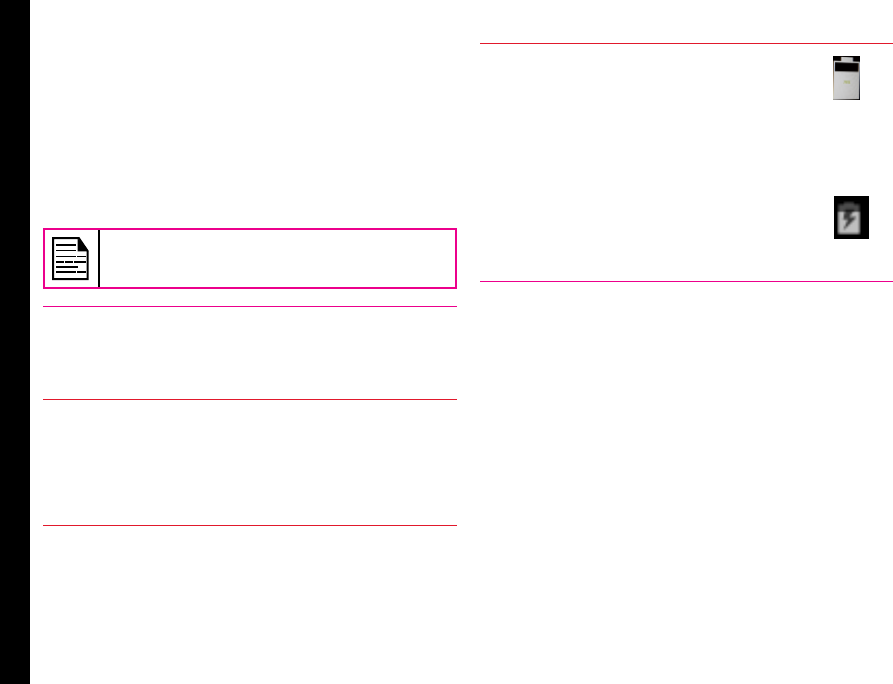
14
Battery usage Guidelines
Battery Usage
Sonim XP6 phone comes with a built-in battery. For any
battery related queries contact Sonim customer support.
Charging the Battery
The battery delivered with your mobile phone is not fully
charged. We recommend that you charge your mobile for
4 hours before you use your mobile phone for the rst
time.
There is a risk of explosion while charging if the
battery has been replaced by an incorrect type.
1 Insert Charger
Insert the charger plug into a power outlet
2 Connect to Phone
The charging port is located in lower side
of the phone, below the back cover. Insert
the charger connector to the charging
port.
3 Charging Animation/Icon
If the battery is being charged when the
phone is switched off, a battery charging
animation with charged percentage is
displayed.
If the battery is being charged while the
phone is switched on, the battery charge
icon on the home screen shows animation
indicating that the battery is being
charged. After the phone is fully charged
the charging animation stops and you can
disconnect the charger from the phone.
Verifying and Optimizing Battery Usage
You can check the battery usage status and also close
some applications to save battery power. In the home
screen, select Settings > Device > Battery.
The current battery charge status (charging or
discharging) and the charge level details are displayed on
the top of the screen.
The discharge graph on the top of the screen shows the
battery level over time since you last charged the device,
and how long you have been running on battery power.
The list at the bottom of the screen shows the breakdown
of battery usage for individual apps and services. Touch
a graph for more details. The details screen for some
apps includes buttons that allow you to adjust settings
affecting power usage, or stop the app completely.

15
Battery Usage Guidelines
If you stop some apps or services, your device
may not work correctly.
Extend the life of your battery
Follow these tips to extend your phone’s battery life.
• If you are not using Wi-Fi, Bluetooth, or GPS, use
the Settings to turn them off. The GPS setting is
located in Settings > Personal > Location.
• Move Maps or Navigation apps to background when
you are not using them. They use GPS (and thus
more power) only when they’re running.
• Set screen brightness to Auto and set a shorter
Sleep timeout (1 minute). The display settings are
located in Settings > Device > Display.
• If you are travelling and do not have access to
mobile or Wi-Fi network, switch to Airplane mode:
Press and hold the power switch until the Phone
options dialog appears. Then touch Airplane Mode.

16
Getting Started
What Is In the Box ?
The list of items in the Sonim XP6 BOLT phone box are:
• Sonim XP6 phone with rechargeable built-in battery
• Quick Start Guide
• Screw driver
• Needle
• Wired headset
• USB Adaptor
• USB Data Cable
• Wall charger
Phone Specifications
Feature Description
Screen Dimension:
Resolution:
Display Type:
Dimension TBD
Weight TBD
Camera Back Camera:
Memory 8 GB or 16 GB (actual formatted
value is less)
2 GB RAM
CPU TBD
Feature Description
Sensors Microphone
Accelerometer
Proximity
Ambient light
Barometer
Gyroscope - optional
Altimeter - optional
Network FDD-LTE (4/17/2/5/7/3/1 ) (B1/
B2/B4/B5/B7/B8/B12/B14/B17),
UMTS(850/900/1900/2100MHz),
GSM(850/900/1800/1900MHz)
3G (850, 900, 1700, 1900, 2100
MHz)
HSPA+ 42
Wireless Wi-Fi - 802.11 a/b/g/n/r with
hotspot function(Max. 5
connections)
Bluetooth
Connectivity charger port name ??
SlimPort HDMI
3.5mm headphone jack
Battery 4800mAh (4 pins) embedded
Standby: up to 250 hours
Talk time: up to 10 hours
Music playback: up to 40 hours
Video playback: up to 8 hours
Web browsing: up to 7 hours
Operating system Kitkat (4.4.2)
Your SIM Card

17
Getting Started
Purchase a SIM card from a mobile operator. The SIM
card associates your network services (for example,
phone number, data services, and so on) with your
phone.
Inserting the SIM Card
1 Switch Off Phone
Ensure that the phone is switched off.
2 Open SIM Covers
Use the multi tool to unscrew the
screws located located near the
antenna, on the top side of the phone.
Remove the covers.
3 Remove SIM Card Holder
Insert the pin provided in the multi-
tool into the pinhole and press down.
The SIM card holder pops up. Use
the pin to hook into the loop on top of
the SIM card holder and remove the
holder completely.
4 Insert SIM Card
Insert the SIM card in the holder and
push the holder into its slot.
5 Reinsert the Covers
Rex both the covers and the screws
using the multi-tool.
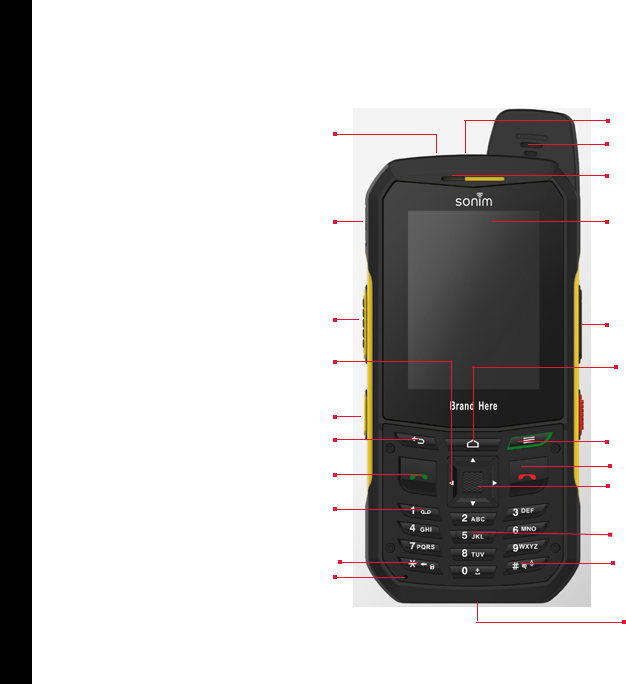
18
Sonim XP6 Phone
Your Sonim XP6
Loudspeaker
Display screen
Options
Power On key
Charger/USB port
Microphone
Headset port
SIM card slot
Receiver
PTT
Camera
Return
Call/Accept
Volume
Call reject/Power On/Off
Home
OK
Navigation Keys
Press and hold to lock the keypad Press and hold to turn
on/off meeting mode
Press and hold to access voicemail Long press 5 to turn
On/Off torch

19
Your Sonim XP6
Switching On
Press and hold the Power ON/OFF key located in the top
corner in the left hand side for 2 seconds to Power ON
the phone.
When the phone is switched on, it tries to register with
the network. After successful registration, the name of
the service provider is displayed.
Setting Up Your Phone
For instructions on using your phone’s buttons, charger,
battery, and other hardware features, check the printed
Quick Reference Guide provided along with your phone.
When you switch ON the phone for the rst time,
Welcome screen is displayed.
• To choose the language, touch the Menu.
• To set up your phone, touch Start and follow the
instructions.
A series of screens takes you through the setup process.
If you already have Gmail account, use your Gmail
address and password or else, create a Gmail account.
You can skip some of the setup steps such as mobile
network conguration and Wi-Fi conguration during this
setup process. Refer to the user guide to congure later.
Need for a Google Account
Your Google Account lets you organize and access
your personal information from any computer or mobile
device:
• When you sign in to your phone with your Google
account, all the contacts you associate with that
account in the People app are automatically backed
up. As a result, they are always accessible through
your Gmail account from any computer. The
contacts are also not lost.
• Synchronize and back up your e-mails, multimedia
les, contact details and events created in your
phone to your Google account. You can use the
download backed up information to any other
computer or mobile device when you login to the
same Google account from that device.
• Protect your personal information as Google
accounts are secure, accessible and password
protected.
• You can use all the Google services such as maps,
navigation, playstore, Google Now, Google Plus and
Google Chrome bookmarks with a single sign-on
user name and password.
Touch and Type Operations
Sonim XP6 is a touch phone. You can use your ngers
to manipulate icons, buttons, menus, and other items
on the touchscreen. To select or activate a feature or
application, touch it.
Other common touch gestures are:
• Touch & hold: Touch & hold an item on the screen
by touching it and not lifting your nger until an
action occurs.
• Drag: Touch and hold an icon for a moment and
then, without lifting your nger, move your nger on
the screen until you reach the target position. For
example, you can drag to reposition shortcuts on
the Home screen.
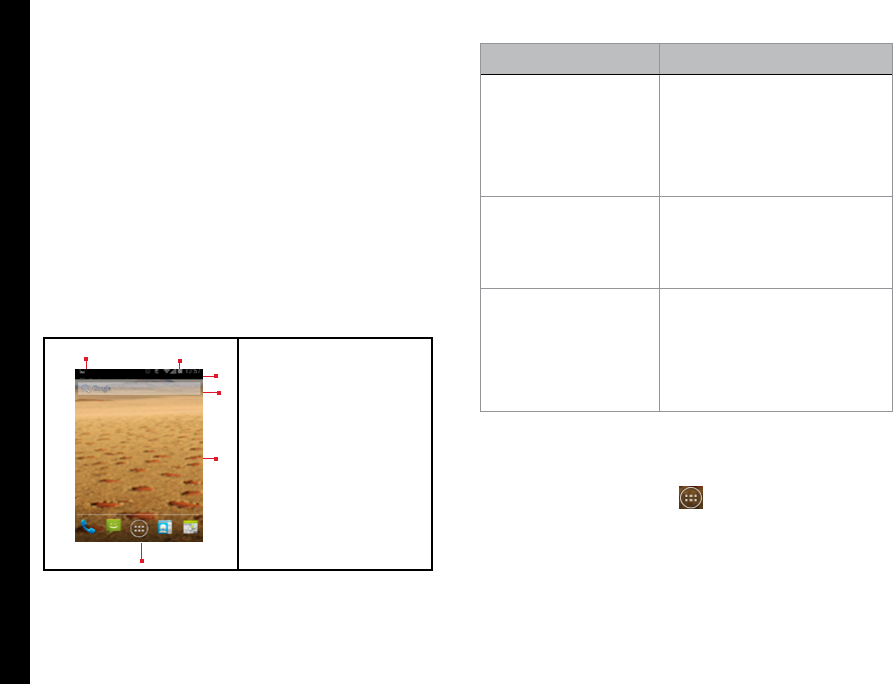
20
Your Sonim XP6
• Swipe or slide: Quickly move your nger across the
surface of the screen, without pausing when you
rst touch (so you don’t drag something instead).
For example, you can slide a Home screen left or
right to view the other Home screens.
• Double-tap: Tap quickly twice on a webpage, map,
or other screen to zoom. For example, doubletap
a webpage in Browser to zoom in, and double-tap
again to zoom out.
Managing Home Screen
After you complete the phone setup, the home screen
is displayed. The home screen is the begining point to
access all the device’s features. The home screen can
have multiple panels. To move between the home panels,
press the navigation keys.
1. Display icons
2. Network type and
Signal strength
indicator
3. Battery charge
indicator and time
4. Home screen
space for
application icons
5. Favorites tray
The navigation keys are located below the display screen.
Keys Description
Back - Opens the previous
screens in the working
sequence till the home screen
is displayed. Once the home
screen is displayed, it remains
there even when you press
the back key.
Home - moves the current
working application to the
recent applications list/
background and displays
home screen.
Recent - displays the
thumbnails of the applications
that you have worked on
recently. To remove any
application from this list,
swipe the application to left
or right.
The Favorites tray is located above the navigation
buttons in the home screen. The app icons you keep in
the tray remain visible on every Home screen panel.
The All Applications icon ( )is always positioned in
the centre of the favorites tray. Touch it to view all the
installed applications and widgets.
The Display icons on the top of the display screen
provides details about various notications such as
missed call, new messages, alarms, events and software
updates.
• To view the notications, swipe your nger down
1
3
2
5
4
4
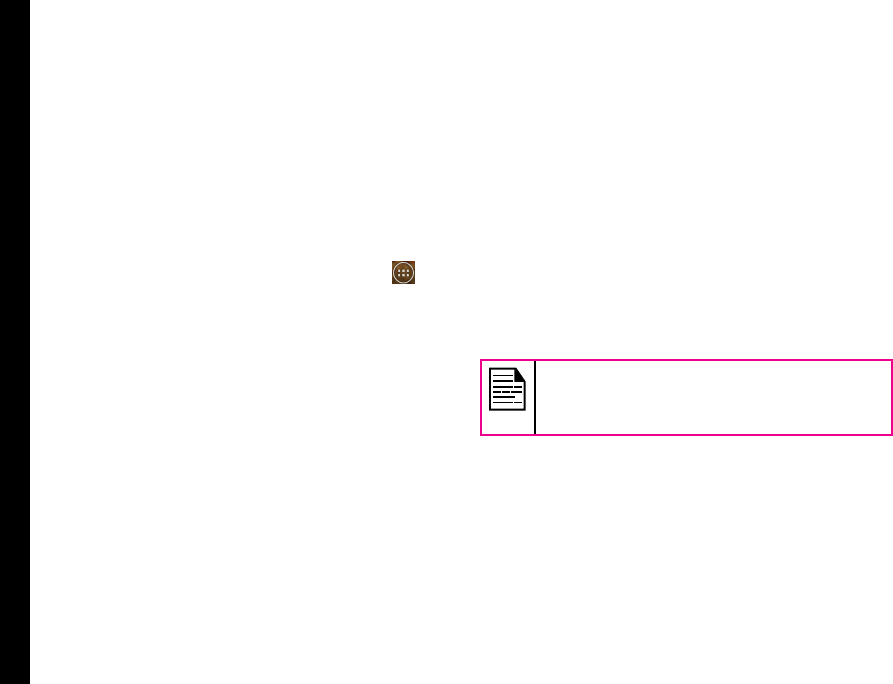
21
Your Sonim XP6
from the top of the screen.
The System icons on the right display the current device
status such as wireless and network connection strength,
battery level and time.
The Google Search bar , just below the status and
system icons, lets you search your phone or the Internet.
Touch Google search bar to type your search terms, or to
speak and give a voice input.
You can save folders, application and widget icons in the
middle of your home screen panel.
Adding an Application Icon to Home Screen
1. On the home screen, tap All Applications ( ).
2. Swipe left or right to locate the application for which
you require a shortcut on the home screen.
3. Touch and hold the application icon and drag it to
the home screen.
• To open an app, folder, or widget, touch its icon.
• To view other Home screens, swipe your nger
quickly left or right.
Creating a Folder on the Home Screen
Folders helps you to keep the icons in an organized
fashion. To create folders,
1. Touch and hold an icon on the home screen or
Applications.
2. Drag and postion it on another icon that should be
included in the same folder.
3. Hold for a about 2 seconds. Both the icons are
grouped together in an unnamed folder.
4. Tap the folder. Tap on the name area and give a
suitable name.
Moving an Icon/Folder from the Home Screen
1. Tap and hold the application icon and drag it to the
new location.
2. To move it to another panel, drag it to the side of the
screen.
Removing an Icon/Folder from the Home Screen
1. Tap and hold the application icon. A Remove icon is
displayed on the top of the home screen.
2. Drag the icon and position it on the Remove icon till
it turns red.
3. Drop the icon and it is deleted from the home
screen.
Deleting an application icon from the home
screen does not delete the application. You
must go to the Applications panel and select
the application to uninstall it.
Home Screen Indicators
The icons displayed at the top of the screen provides
information about the status of the device. Details such
as date and time, battery charge status, and data service
and Wi-Fi connectivity are displayed when the phone
is in standby mode. Other indicators such as Bluetooth
connectivity status, airplane mode, alarm and call forward
are displayed, if the feature is activated.
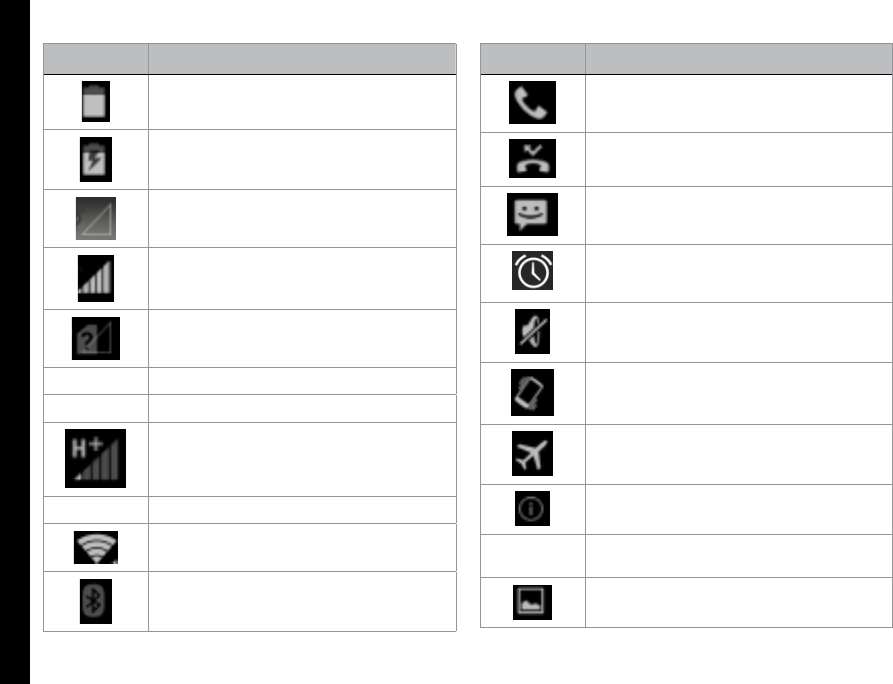
22
Your Sonim XP6
Icons Description
Battery level indicator
Battery charging in progress
No signal
Signal strength
No SIM card
Currently accessing SIM card
Roaming
GPRS network connected
EDGE network connected
Wi-Fi connected
Bluetooth activated
Icons Description
Call in progress
Missed call
New SMS or MMS
Alarm activated
Silent mode activated
Vibration mode activated
Flight mode activated
Error/information notication - attention
required
Synced with the associated account
such as Google
Screenshot captured
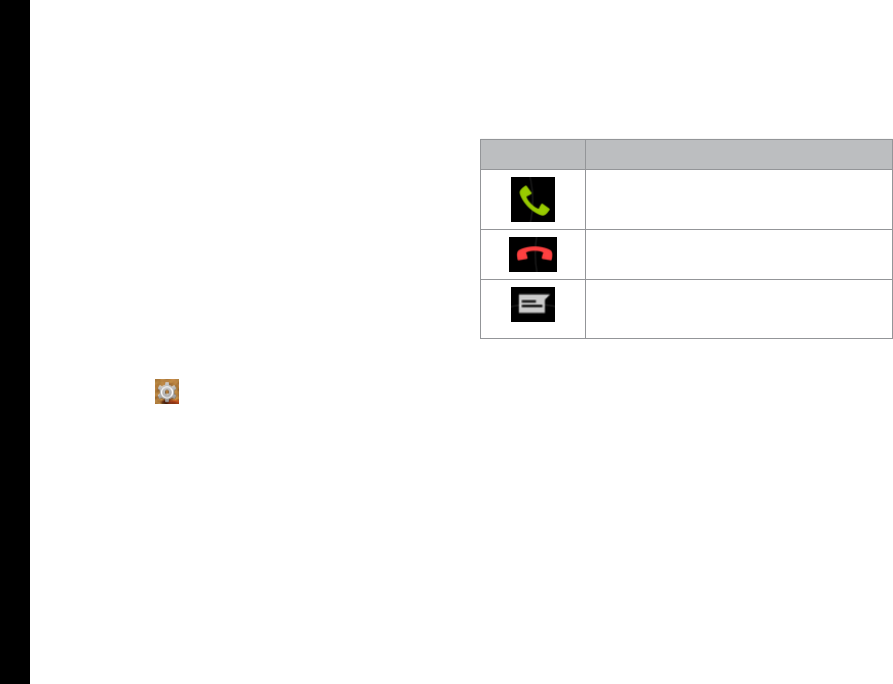
23
Your Sonim XP6
Phone Operations Without SIM Card
You can perform the following operations without
inserting a SIM card in your phone.
• View and modify all settings except Data usage and
mobile network related settings.
• Activate and share les through Bluetooth.
• Activate and access the Internet, and all your
synced accounts using Wi-Fi connectivity.
• Access your phonebook, my les, multimedia les,
all tools and applications.
• View and modify your prole settings.
Setting up and Using Lock Screen
You must lock your phone to protect it from unauthorized
access.
1. From the Home or All Applications screen, tap
Settings ( ).
2. Scroll down and tap Security, located under
Personal settings.
3. Tap Screen lock and select one of the following
options to congure phone:
• None: Disables the phone lock.
• Slide: When the phone is locked slide to your
right or long press * key to unlock the phone.
• PIN: When enabled, enter you own PIN value.
When the phone is locked, unlock it using the
PIN.
• Password: When enabled, enter your own
password. When the phone is locked, unlock it
using the password.
When the phone is locked, you can answer an incoming
call, without unlocking the phone. Touch the white phone
icon and slide over one of these icons:
Icons Description
Answer the call.
Disconnect the call.
Disconnect the call and respond with
a default text message from a list of
response text messages.
Changing the Wall paper
You can set an image or a photo stored in your phone as
your home sceen wall paper. To change the wall paper,
1. Tap and hold on the Home screen. Choose Wall
paper screen is displayed.
2. Select from one of the following Wall paper
collections
• Gallery: includes photos and screenshots
taken using the phone’s camera.
• Live Wallpapers: includes animated wall
papers.
• Wallpapers: includes images that are pre-
bundled with the phone.

24
Your Sonim XP6
Taking a Screenshot
You can take the screenshot of the current screen and it
is stored in your phone’s gallery. To take a screenshot:
1. Ensure that the image to be captured is displayed in
the current screen.
2. Press the Power and Volume down button
simultaneously. The screnshot is captured and
stored in the gallery. A screenshot captured icon (
) is also displayed in the home screen top bar.
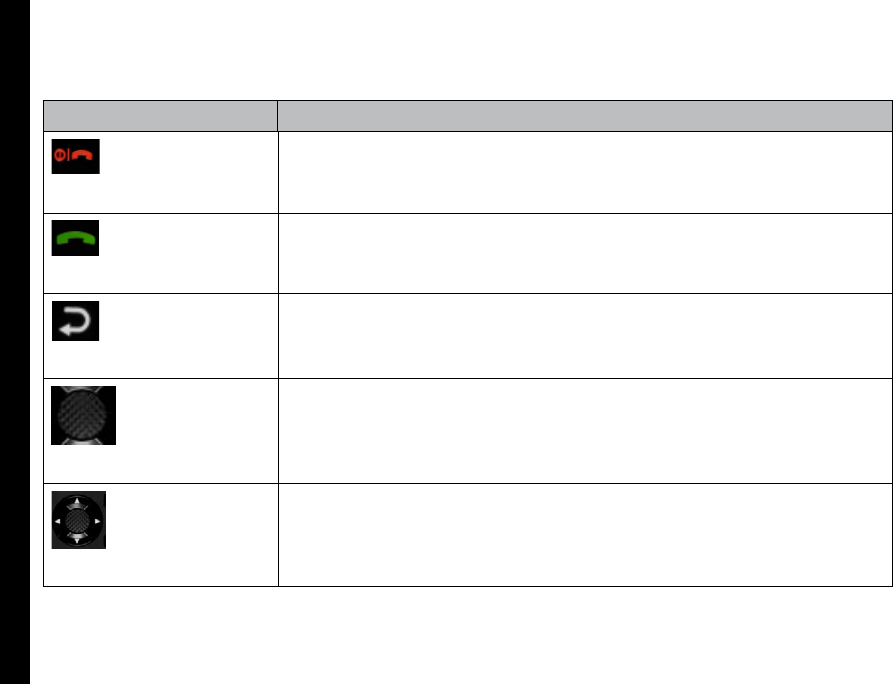
25
Your Sonim XP6
Keypad Functions
The following table displays the various keys and the corresponding functions they perform:
Keypad key Operations
POWER ON/OFF/END CALL
• Press to end a call.
• Press when in another application screen, to return to home screen.
• Press to reject an incoming call.
CALL/ACCEPT/SEND
• Press to answer an incoming call.
• After entering a phone number, press to make a call.
• Press while in Standby mode to access last received or dialed call list.
BACK
Present above the Call accept key. Press this key to go back to the previous
screen. You can press till you reach the Home screen.
MENU KEY (CENTRE)
Press to perform a specic operation on a selected application.
NAVIGATION KEYS
Press to navigate in up, down, left and right directions.
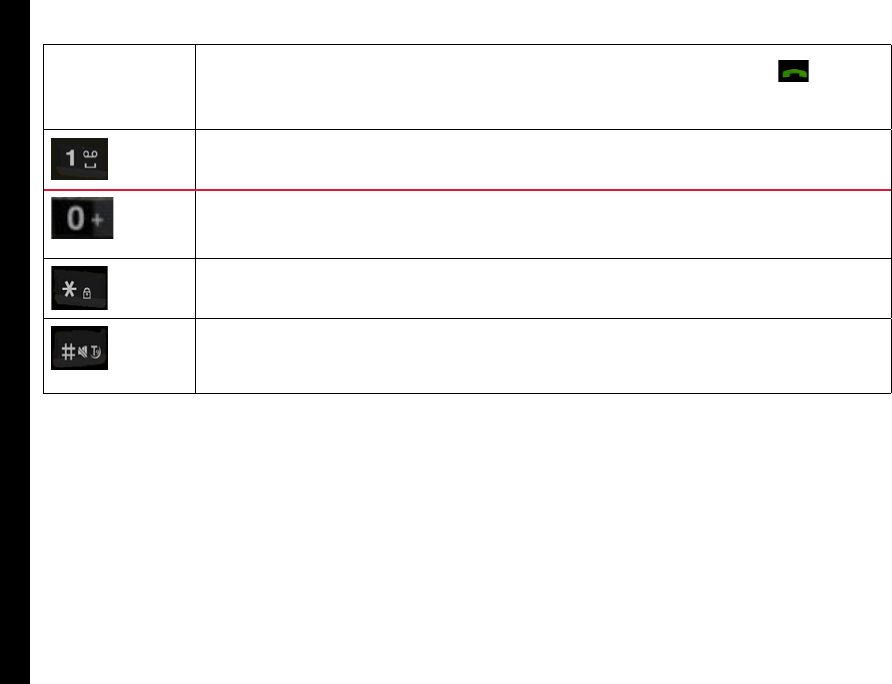
26
Your Sonim XP6
ALPHA-NUMERIC
KEYS
• Press the required keys (0-9) to enter the desired phone number and press to make
a call.
• Enter text while in the text editor.
• Press and hold in standby mode to access your Voice mail..
• Press and hold to display ‘+’ used for dialing an international number, while in standby
mode.
• On editor screen, press 0 to get blank space in T9 or normal mode.
• Press and hold to lock/unlock the keypad.
• Press and hold in standby mode to switch between Meeting on/off modes.
• When entering text, press to switch between lower case, upper case or numeric.
• Press and hold to enable/disable T9 mode.
• Press and hold to change the language, when entering text.
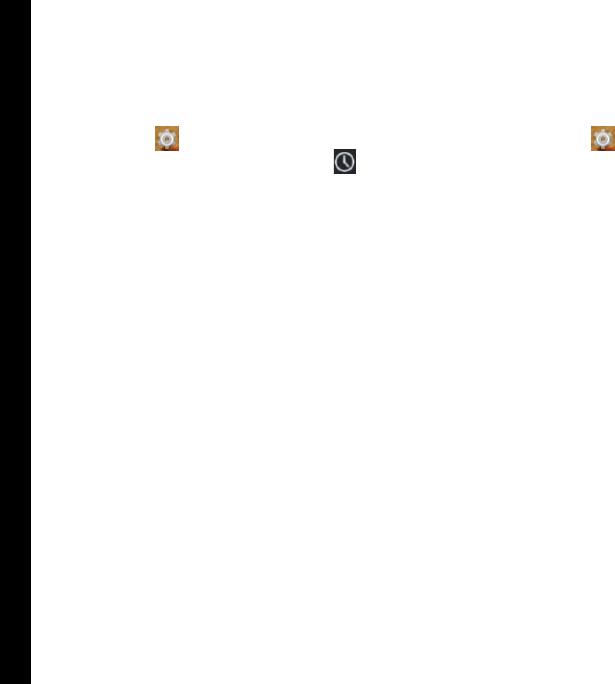
27
Managing Phone Settings
Time and Date Settings
You can set and display the date and time on the phone.
You can also select the display format.
1. From the Home or All Applications screen, tap
Settings ( ).
2. Scroll down and tap Date & Time ( ), located
under Personal settings.
3. Select one of the following options to congure
phone:
• To synchronize the date and time with the
network provided time enable Automatic date
and time.
• To synchronize the time zone with the network
provided time enable Automatic time zone.
• To set the date manually, tap Set date. Scroll
and select the date, month and year. Tap Done.
• To set the time manually, tap Select time.
Scroll and select the hour and minute. Tap
Done.
• To set the time zone, tap Select time zone.
Scroll and select your time zone.
• To set the clock to 24-hour format enable Use
24-hour format. By default, the phone is set to
24-hour format.
• To set your preferred date format, tap Choose
date format. The date formats supported
are Regional (the standard format supported
by that country or region, MM DD YYYY, DD
MM YYYY, YYYY MM DD with / as the date
separator).
Language and Input Settings
You can set the phone’s language to either US Spanish or
english preferred language.
1. From the Home or All Applications screen, tap
Settings ( ).
2. Scroll down and tap Language & input , located
under Personal settings.
3. Select English or US Spanish as your preferred
language.
All the menu items, user feedback messages and text
entry language are displayed in the set language.
Spell Checker Settings
Enable Spell checker, to verify and change the spellings
when you type your text message or mail.
Personal Dictionary Settings
The default keyboard input language is set to English
(United States)/Spanish (United States) - T9 format.
This cannot be modied.
Speech Settings
• Tap Speech rate, to set the Speech input rate to a
comfortable speed.
• Tap Listen to an example to verify the set speech
rate.
• Tap Default language status, to view the default
language for speech input.
Mouse/Pointer Settings

28
Managing Phone Settings
Tap Pointer speed to set the your phone’s touch pointer
sensitivity to a comfortable level.
Display Settings
1. From the Home or All Applications screen, tap
Settings ( ).
2. Scroll down and tap Display, located under Device
settings.
3. Set one of the following options to congure your
phone’s display:
• Brightness: Set the brightness of the phone
display. It is recommended to set to Auto
so that the display brightness is adjusted
automatically based on the brightness of the
surroundings. This also optimizes the battery
power consumed.
• Wallpaper: Set the wallpaper for your home
screen. You can select from one of the
following wallpaper collections:
• Gallery: includes photos and screenshots
taken using the phone’s camera.
• Live Wallpapers: includes animated
wallpapers.
• Photos: includes photos stored in your
Google photos.
• Wallpapers: includes images that are pre-
bundled with the phone.
• Sleep: Set the sleep time so that the screen
brightness is turned down after specied time
of phone inactivity. This setting also optimizes
the battery power.
• Daydream: Enable this to activate the screen
saver after specified time of phone inactivity.
You can set the screen saver to one of the
following options. Tap the Settings icon ( )
next to each option, to customize the screen
saver.
• Clock: Displays the current system clock.
• Colors: Displays the seven colors of
spectrum with various transition effects.
• Photo Frame: Displays the photos present
in the gallery and screenshots as full screen
images.
• Photo Table: Displays the photos present
in the gallery and screenshots as assorted
images.
• Font size: Set the font size of the text
displayed in the screen.
• Cast screen: Connect your phone to any other
nearby device using wireless connection and
view your phone’s screen in that device. For
more information refer “Connecting a Wirelss
Display Device” on page 29.
Power Saving Settings
Viewing Battery Life
To view the battery life when all the apps are running,
1. From the Home or All Applications screen, tap
Settings ( ).
2. Scroll down and tap Battery, located under Device
settings.
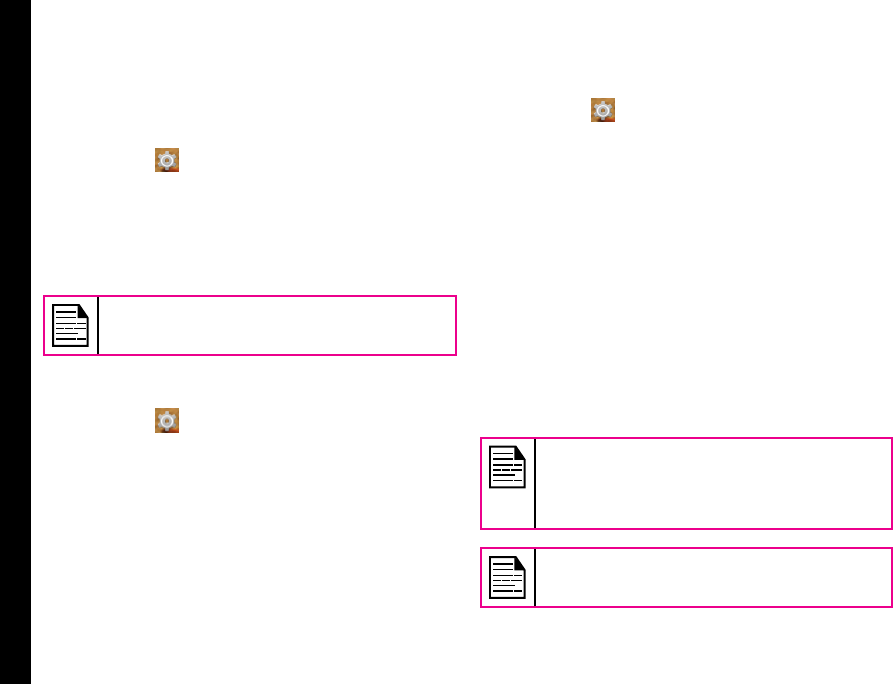
29
Managing Phone Settings
The battery life and list of running applications is
displayed.
Force Stopping an Application
1. From the Home or All Applications screen, tap
Settings ( ).
2. Scroll down and tap Apps , located under Device
settings.
3. Tap All to view all the applications.
4. Tap the application to be force stopped.
5. Tap Force stop to stop an application.
If you stop some apps or services, your device
may not work correctly.
Reporting an Issue with Application
1. From the Home or All Applications screen, tap
Settings ( ).
2. Scroll down and tap Apps , located under Device
settings.
3. Tap Running to view all the running applications.
4. Tap the application to be force stopped.
5. Tap Report to report an issue.
Connecting a Wirelss Display Device
You can utilize the wireless display feature and stream
videos and audio to other displays that support cast
screen feature. You can perform screen cast from your
phone either using a standard wireless router or even
without it.
1. From the Home or All Applications screen, tap
Settings ( ).
2. Scroll down and tap Display, located under Device
settings.
3. Scroll down and tap Cast screen. A list of display
devices that support cast screen are displayed.
Select a device and tap OK.
Connecting a PC Using USB Connection
You can connect your phone to PC as a Media device
(MTP) using USB cable. When the phone is connected to
the computer via a USB cable, the following two options
are displayed:
• Media device (MTP): Select this to use the phone
as Media device (MTP) device to transfer data
between your Sonim phone and your computer.
• Camera (PTP): Select this to transfer photos and
les that do not support MTP.
When the phone is connected to the computer
via USB cable, you can select only to charge
the phone by pressing the Back button. You
need not select the Media device (MTP) or
Camera (PTP) option.
When the phone is connected to the computer
via USB cable in Media device (MTP) mode
phone memory is displayed in the computer.
Viewing Device Details

30
To view the device details such as system update status,
model number, Android version, Kernel and baseband
versions,
1. From the Home or All Applications screen, tap
Settings ( ).
2. Scroll down and tap About Phone, located under
System settings.
Managing Memory Utilized by Applications
The Apps screen allows you to optimize memory usage
for all the applications. To view these settings,
1. From the Home or All Applications screen, tap
Settings ( ).
2. Scroll down and tap Apps , located under Device
settings. The following tabs are displayed:
• Downloaded: Displays all applications
downloaded from Google Play or other
sources.
• Running: Displays all applications, processes,
and services that are currently running or that
have cached processes, and the details about
the RAM utilized by each application.
• The graph at the bottom of the Running tab
shows the total RAM in use and the amount
free. Touch SHOW CACHED PROCESSES or
SHOW RUNNING SERVICES to switch back
and forth.
• All: Displays all applications that are pre-
bundled with Android and downloaded from
Google Playstore or other sources.
Optimizing Memory Usage
You can optimize your phone’s memory by performing
the following tasks:
• Uninstall apps that are not required.
• Delete unwanted les that are downloaded or
created.
• Transfer les that would be required later to your
computer.
• Delete ofine content from Google Play and stream
it via a Wi-Fi or mobile network.
Managing Phone Settings
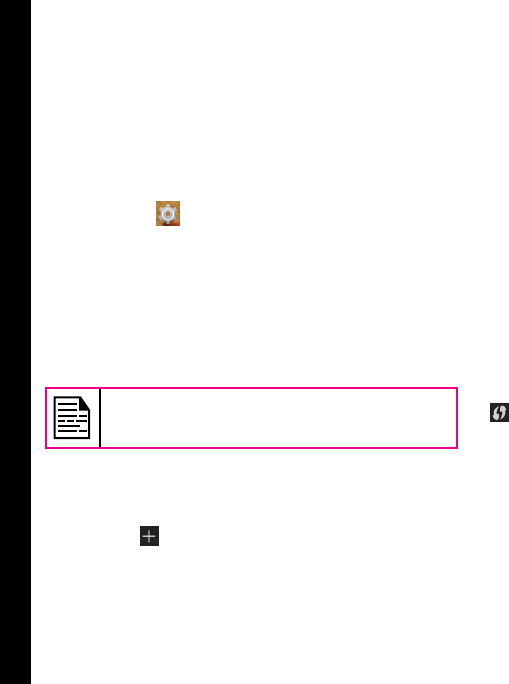
31
Managing Wireless and Network Settings
Connecting to Wi-Fi Network
Wi-Fi is a wireless network technology that can provide
Internet access at distance upto 100 Feet, depending
on the Wi-Fi router and surroundings, when you connect
your mobile device to the wireless router.
You can access Internet when you connect your XP6 to a
Wi-Fi network. To connect your phone to a Wi-Fi network,
1. From the Home or All Applications screen, tap
Settings ( ).
2. Enable Wi-Fi , located under Wireless & Networks
settings.
3. Tap Wi-Fi. A list of Wi-Fi routers present within your
phone’s accessible range are displayed.
4. Tap your preferred network. Enter the WEP/
WPS/ WPA key (if it is a secured network) and tap
Connect. To verify the password before connecting,
enable Show password.
It is always recommended to make your Wi-Fi
router secure and also to connect your phone
to a secure network.
Adding a New Network
To add a new Wi-Fi network
1. In the Wi-Fi settings screen,Tap Add Network
button ( ).
2. Enter the following details:
• Network SSID: The wireless network ID.
• Security: Set the security type to None, WEP,
WPA/WPA2 PSK, 802.1x EAP.
3. Enable Advanced Settings to set the Proxy details
and IP settings.
Editing a Network
1. Press and hold your preferred network.
2. Select Modify Network. The network setting
details such as connection status, signal strength,
connection speed, security type, IP address and
password are displayed.
3. Tap Save to save the settings or Cancel to exit to
the previous screen.
Forgetting a Network
1. Press and hold your preferred network.
2. Select Forget Network. The selected network is
removed from the list.
Enabling WPS For your Router
To setup a secure Wi-Fi network, press WPS Push button
( ) in the Wi-Fi network Settings and press the WPS
button in your router, when prompted.
Connecting to Bluetooth Devices
Bluetooth is short-range wireless communication
technology used to communicate between the devices
over a distance of about 8 meters.
You can perform the following tasks using Bluetooth
paired devices.
• Transfer media les and contacts between mobile
devices connected using Bluetooth.
• Access Internet through a Bluetooth device that is
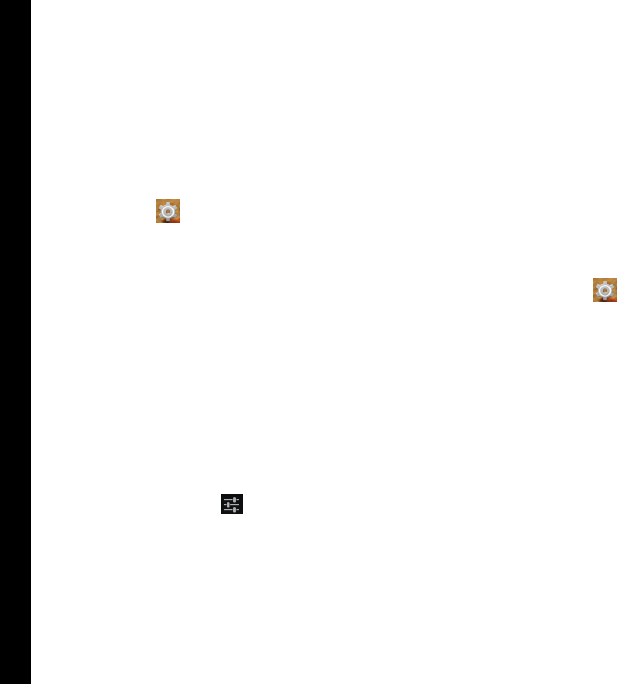
32
Managing Wireless and Network Settings
connected to a Wi-Fi router.
• Use Bluetooth connected headphones for playing
media le
Pairing a Bluetooth Device
To activate Bluetooth and pair your XP6 phone with other
Bluetooth devices:
1. From the Home or All Applications screen, tap
Settings ( ).
2. Enable Bluetooth , located under Wireless &
Networks settings.
A list of accessible Bluetooth devices are
displayed.
Ensure that Bluetooth is activated in the other
device too.
3. Select and tap your preferred device.
4. Conrm the pass key in the other device and tap
Pair in your phone.
The device is displayed in the Paired device list.
Editing Bluetooth Device Settings
1. Tap Settings icon ( ) located next to the
preferred paired Bluetooth device.
2. Tap Rename to rename the display name of the
device .
3. Tap Unpair to remove the device from your paired
list.
4. Enable Media Audio to connect the Bluetooth
device for listening to media les.
5. Enable Internet access to use the paired Bluetooth
device to access the Internet.
Optimizing Data Usage
Data usage refers to the amount of data utilized by
your phone during data transfers through Internet. The
data usage charges are dependent of the wireless plan
provided by your service provider.
To monitor your data usage, adjust your data usage
settings.
1. From the Home or All Applications screen, tap
Settings ( ).
2. Enable Data Usage, located under Data usage
settings.
3. Enable Mobile Data to access Internet using your
mobile network.
4. Enable Set mobile data limit to preset your data
usage limit and to set an alert before reaching the
preset limit.
5. Drag the red bar to set the Data usage limit.
Mobile data access is disconnected automatically as
soon as you reach this limit. You cannot access the
Internet and related phone features do not work. You
receive a notication once you reach the set data
usage limit.
6. Drag the yellow bar to set data usage warning so
that you receive an alert before reaching your set
data usage limit.
Activating Airplane Mode

33
Managing Wireless and Network Settings
When your phone is set in airplane mode, network
connectivity or mobile data connectivity is disabled.
But you can access your camera, medial les and other
features that do not require mobile connectivity. To
activate airplane mode
1. From the Home or All Applications screen, tap
Settings ( ).
2. Tap More located under Wireless & Networks
settings.
3. Enable Airplane mode.
Setting Up Tethering & portable hotspot
Using tethering and portable hotspot you can share your
device’s network connection with a computer or with up
to other devices, via USB, Wi-FI, or Bluetooth. To activate
USB tethering,
1. Tap More located under Wireless & Networks
settings.
2. Tap Tethering & Portable hotspot.
3. Enable USB tethering.
Setting Up Wi-Fi Hotspot
When you setup your phone as a Wi-Fi hotsopt you can
connect other devices to this phone through Wi-Fi and
access Internet.
1. Tap More located under Wireless & Networks
settings.
2. Tap Tethering & Portable hotspot.
3. Tap Set up Wi-Fi Hotspot.
4. Enter Network SSID, security details and
password and tap Save.
Activating Bluetooth Tethering
When you activate Bluetooth tethering, you can share
your phone’s Internet connection with other Bluetooth
paired devices.
1. Tap More located under Wireless & Networks
settings.
2. Tap Tethering & Portable hotspot.
3. Enable Bluetooth tethering.
4.
Managing Mobile Network
You can view and modify your mobile service provider
settings. To view and modify your mobile network
settings,
1. From the Home or All Applications screen, tap
Settings ( ).
2. Tap More located under Wireless & Networks
settings.
3. Tap Mobile network settings.
4. Enable Data enabled to access the Internet using
your mobile network.
5. Enable Data roaming to have network connectivity
when you are in a roaming network.
6. Select the preferred Network type.
7. Tap Access Point Names to view and edit the
network access points.Tap Add network icon ( )
to add a new access point.

34
Managing Wireless and Network Settings
8. Tap Network operator to view and modify your
network operator from the list of available networks.
Managing Cell Broadcasts
You can activate cell broadcasts to get emergency
and important broadcast messages from your service
provider.
1. From the Home or All Applications screen, tap
Settings ( ).
2. Tap More located under Wireless & Networks
settings.
3. Tap Cell Broadcasts. Enable the broadcast
message types such as extreme threats, severe
threats and amber alerts, that you would wish to
receive.
4. Enable Turn on alert notication to receive
notications when alerts are sent to your phone.
5. Set the Alert sound duration.
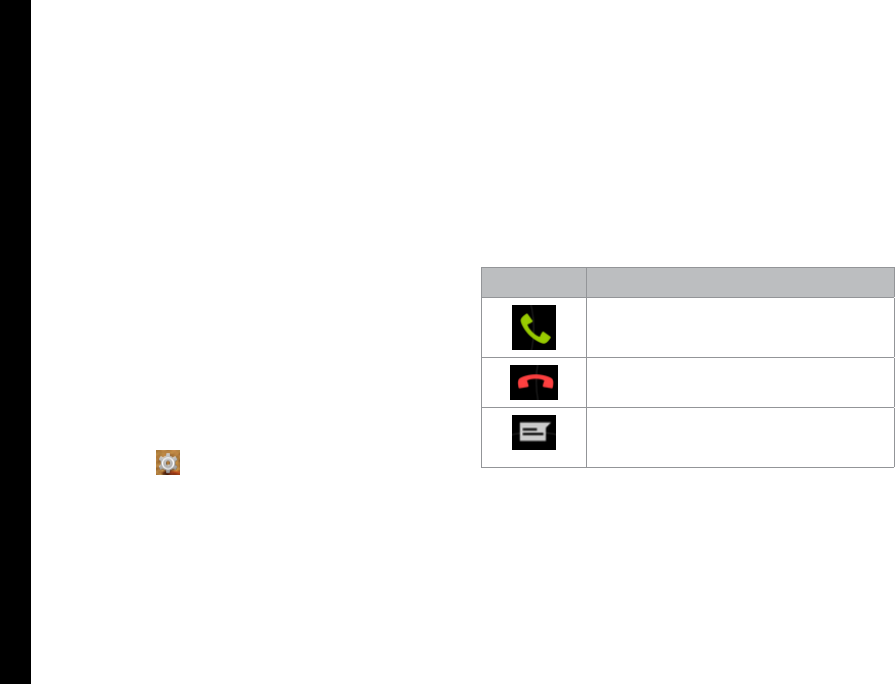
35
Managing Phone Security Settings
About Android Security
Android provides a multi-layered approach to the
security.
• Prevent: Apps in Google Play are scanned
continuously to block harmful apps and policy
violators. You can also choose to have apps
installed from other sources veried.
• Control: App sandboxes prevent apps from
accessing other parts of your device’s operating
system, or each other, unless you give permission
during installation. Screen lock and encryption
prevent unauthorized access to the entire device.
• Defend: Once identied, dangerous apps can be
removed remotely.
For more information about protecting your phone, refer
to the topics below.
Managing Security Settings
You can activate and protect your phone from
unauthorized by conguring the security settings.
1. From the Home or All Applications screen, tap
Settings ( ).
2. Tap Security located under Personal settings.
Enable and mody required security settings.
Locking your Screen
1. Tap Screen lock and select one of the following
options to congure phone:
• None: Disables the phone lock.
• Slide: When the phone is locked slide to your
right or long press * key to unlock the phone.
• PIN: When enabled, enter you own PIN value.
When the phone is locked, unlock it using the
PIN.
• Password: When enabled, enter you own
password. When the phone is locked, unlock it
using the password.
When the phone is locked, you can answer an
incoming call, without unlocking the phone. Touch
the white phone icon and slide over one of these
icons:
Icons Description
Answer the call.
Disconnect the call.
Disconnect the call and respond with
a default text message from a list of
response text messages.
2. Check Enable Widgets to view the selected widget
shortcuts in the lock screen.
3. Enable Owner Info to display your specic owner
info in the lock screen. You can modify this detail
whenever required.
Encrypting Phone Data
You can encrypt your accounts, phone settings,
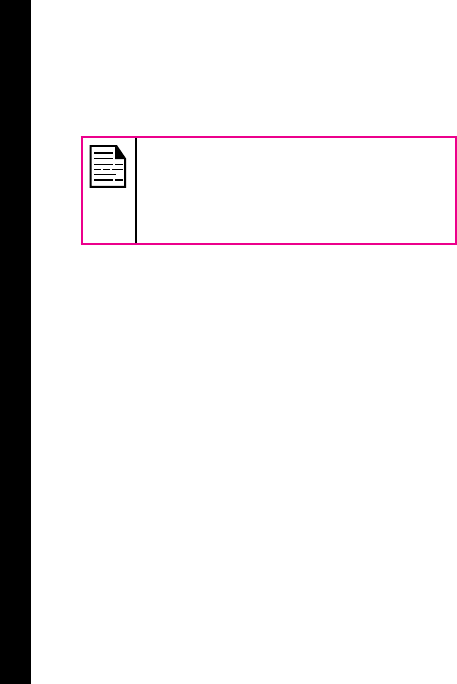
36
Managing Phone Secutrity Settings
downloaded applications, contacts, messages data and
media les.
Tap Encrypt phone to encrypt your phone data. You
require a numeric PIN or password to decrypt the
data when ever you switch ON the phone.
Encryption takes atleast an hour
depending on the amount of data to be
encrypted. Hence, ensure that your phone
is fully charged before you encrypt it.
If data encryption is interrupted, you might
lose your phone data.
Locking Your SIM Card
You can activate and set a SIM lock to unlock your SIM,
when ever you power ON the phone.
1. Tap Setup SIM/RUIM card lock.
2. Enable Lock SIM card.
To disable this option you must enter your SIM lock
PIN.
3. Tap Change SIM PIN. Enter the old pin and tap OK.
4. Enter the new PIN and re-enter the same value when
asked. Tap OK.
Managing Credential Certificates
You can view, install, verify and manage the certicates
installed in your phone.
• Tap Trusted Credentials to view and verify the
system and user certicates.
• Tap Install from Storage to view and install new
user certicates.
Protecting your Phone from Harmful Applications
Some applications can harm your device. It is
recommended to verify apps in order to help prevent
harmful software from being installed on your device.
To prevent installation of application from unknown
sources, disable the option Unknown sources.
If you want to install applications from unknown sources,
enable Verify apps under Settings > Security, to verify if
the application is safe for installation.

37
Managing Personal, Account and System Settings
Location Access
If you enable Location services, your location is displayed
in all your accounts.
1. From the Home or All Applications screen, tap
Settings ( ).
2. Tap Location located under Personal settings.
Enable and modify required security settings.
3. Enable Location.
4. Set the Location mode to one of the following
options:
• High accuracy: uses GPS, Wi-Fi, mobile
networks, and other sensors to get the highest-
accuracy location for your device. It uses
Google’s location service to help estimate your
location faster and more accurately.
• Battery saving: allows your device to estimate
your location using low battery-intensive
location sources, such as Wi-Fi and mobile
networks. It uses Google’s location service to
help estimate your location faster and more
accurately.
• Device only: allows your device to estimate
your location using GPS only. It doesn’t use
Google’s location service to provide location
information. This mode may use more battery
power and take longer to determine your
location.
Backup and Restore Data
You can backup your phone data to one or more of your
Google accounts using Android backup services. If you
need to replace your device or erase its data, you can
restore your data for any accounts that were previously
backed up.
To backup your data,
1. From the Home or All Applications screen, tap
Settings ( ).
2. Tap Backup & reset located under Personal
settings.
3. Enable the option Back up my data.
Managing Accounts
You can link an existing Google account to your phone to
organize and access your personal information from any
computer or mobile device.
Adding an Account
1. From the Home or All Applications screen, tap
Settings ( ).
2. Tap Accounts located under Account settings.
3. Select the type of account. You can create a
Corporate account or an IMAP account.
4. Complete the on-screen instructions.
The account is displayed under one of the following
list:
• Google accounts shown under Settings >
Accounts > Google.
• Other accounts shown under Settings >
Accounts.
Deleting an Account

38
Managing Personal, Account and System Settings
You can remove any account and all the information
associated with it from your device, including e-mail,
contacts, settings, and other data backed up in that
account.
1. To remove a Google account , tap the name in
Settings > Accounts or Settings > Accounts >
Google.
2. Tap Menu > Remove account.
To remove any other type of account, tap Settings
> Accounts > account-name and tap the suitable
Remove option.
Syncing Your Account
To view and modify the sync settings for Google
accounts,
1. From the Home or All Applications screen, tap
Settings ( ).
2. Tap Accounts located under Account settings.
3. Tap Google account.
Adding an Account
To enable auto-sync for all apps that are linked with your
account,
1. From the Home or All Applications screen, tap
Settings ( ).
2. Tap Wirelss & networks located under Account
settings.
3. Tap Data usage > Menu > enable Auto-sync data.
If this option is not checked, you can only sync the
sync data manually. You can also sync manually
to collect messages, e-mail, and other recent
information.
If auto-sync is disabled. it extends your phone’s
battery life. But it prevents your from receiving
notications when updates occur.
Congure Google Account Sync Settings
To modify a single Google account’s sync settings:
1. From the Home or All Applications screen, tap
Settings ( ).
2. Tap Accounts located under Account settings.
3. Tap Google account.
• Indicates that some or all of an account’s
information is congured to sync automatically.
• Indicates that none of an account’s information
is congured to sync automatically
4. Tap the specic account, to change the sync
settings.
5. If auto-sync is enabled, you can check or uncheck
items to be synced automatically for that account.
If auto-sync is off, touch an item to manually sync
its data.
Sync a Google Account Manually
1. In the Google settings screen, touch the account
whose data has to be synced.
2. Tap Menu > Sync now.

39
Managing Personal, Account and System Settings
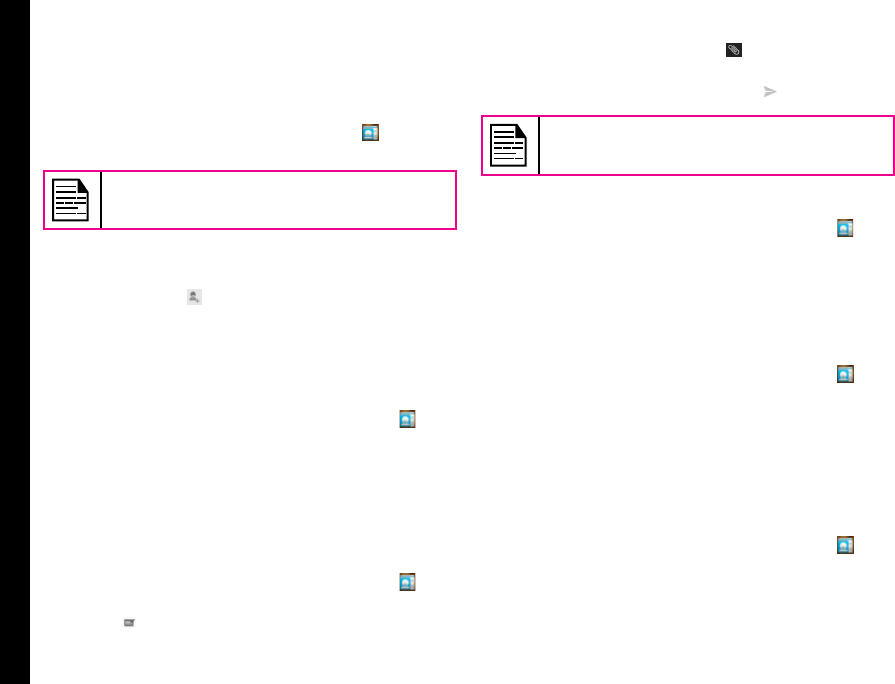
40
Managing Contacts
You can use the phonebook to maintain phone numbers
of your contacts. This feature enables you to add, delete,
dial phone numbers, send SMS and MMS messages.
To access the contacts,
From Home or All apps screen, tap People ( ) .The
contacts saved in the phonebook are displayed.
You can touch and drag the scroll bar on the
screen to scroll through the contacts.
Add a New Contact
• To add a new contact, tap Menu > People > Add
new contact ( ). Enter the contact details and tap
Done to save the contact.
• You can also enter a number using the dial pad and
tap Add to contacts to add a new contact.
View the Contact Details
1. From Home or All apps screen, tap People ( ).
2. Scroll to the required contact and tap the contact, to
view the contact details.
Sending a Message from Contacts
You can send SMS and MMS messages to the contacts.
Sending SMS/MMS
1. From Home or All apps screen, tap People ( ).
2. Scroll to the required contact and tap the Message
icon ( ), to open the message screen.
3. (Optional). Tap Attachment ( ), to attach a
multimedia le.
4. Type the message and tap Send ( ).
If you attach a media le or a contact to your
SMS message it is converted to an MMS
message automatically.
Dialing a Number from Contacts
1. From Home or All apps screen, tap People ( ).
2. Scroll to the required contact and tap the contact to
view the contact details.
3. Tap the required phone number to dial the contact or
press the OK key to dial the default number.
Editing the Contact Details
1. From Home or All apps screen, tap People ( ).
2. Scroll to the required contact and tap the contact,
tap the contact to view the contact details.
3. Press the Options key located about the Call end
button and select Edit.
4. Edit the required details and tap Done.
Importing SIM Card Contacts to Phone
1. From Home or All apps screen, tap People ( ).
2. Scroll to the required contact and tap the contact,
tap the contact to view the contact details.
3. Press the Options key located about the Call end
button and select Import/Export.

41
Managing Contacts
4. Tap Manage SIM Card contacts.
The list of contacts stored in your SIM card is
displayed.
5. Tap the contact to be moved to the phone.
The contact is imported to the phone address
book.
Exporting Phone Contacts to SIM Card
1. From Home or All apps screen, tap People ( ).
2. Scroll to the required contact and tap the contact,
tap the contact to view the contact details.
3. Press the Options key located about the Call end
button and select Import/Export.
4. Tap Export to SIM card.
The list of contacts stored in your phone address
book is displayed.
5. Check the contacts to be moved to the phone.
The contacts are exported to the SIM card.
Exporting Phone Contacts to Storage
1. From Home or All apps screen, tap People ( ).
2. Scroll to the required contact and tap the contact,
tap the contact to view the contact details.
3. Press the Options key located about the Call end
button and select Import/Export.
4. Tap Export to storage.
All the contacts are exported to your computer as
.VCF le.
Sharing Contacts Via MMS, Bluetooth, Drive and E-mail
You can send contact information by MMS, e-mail or
Bluetooth.
1. From Home or All apps screen, tap People ( ).
2. Scroll to the required contact and tap the contact,
tap the contact to view the contact details.
3. Press the Options key located about the Call end
button and select Import/Export.
4. Tap Export to storage.
5. Tap Share visible contacts.
6. Select one of the following options to share the
required contact and tap Just Once to select the
transfer mode every time or Always to send the
contact using the same method:
• Bluetooth: Send the contact details to a
Bluetooth device paired with your phone.
Select the Bluetooth device to share the
contact.
• E-mail: Send the contact details as an e-mail
message. Ensure to setup your e-mail account
before sending e-mail messages. Else you are
requested to setup the e-mail account.
• Messaging: Send the contact details as a
multimedia message to any mobile phone.
• Gmail: Send the contact details as an email
using your congured Gmail account.
• Drive: Save and share the contact details
through Google drive.
You can also share a single contact.

42
Managing Contacts
1. Scroll to the required contact and tap the contact,
tap the contact to view the contact details.
2. Press the Options key located about the Call end
button and select Share.
3. Select the sharing option from Bluetooth, E-mail or
Messaging and share the contact.
Creating Caller Groups
Syncing Your Phone Contacts with Google Account
Managing Contact Settings
You can edit and modify ringtone and call receiving
settings for individual contacts.
1. From Home or All apps screen, tap People ( ).
2. Scroll to the required contact and tap the contact,
tap the contact to view the contact details.
3. Press the Options key located about the Call end
button and select one of the following options:
• Set ringtone to set a specic ringtone for that
contact.
• Enable All calls to voice-mail to forward all
incoming calls from that contact to your voice-
mail box.
• Select Place on Home screen to copy the
contact widget to the Home screen for easy
access.
Managing Phonebook Settings
You can set the sort list to view the contacts and also the
rst or last name of the contact to be displayed rst.
1. From Home or All apps screen, tap People ( ).
2. Press the Options key located about the Call end
button and tap Settings. Set the following options:
• Sort list by: Sort the contact names by rst
name or last name.
• View Contact names: Set the contact display
name to rst name or last name.
Searching Contacts
1. From Home or All apps screen, tap People ( ).
2. Tap Search ( ) and enter the rst few letters/
numbers of the contact name/phone number to be
searched.
All the contacts containing the search text are
displayed.
Deleting a Contact
1. From Home or All apps screen, tap People ( ).
2. Scroll to the required contact and tap the contact,
tap the contact to view the contact details.
3. Press the Options key located above the Call end
button and select Delete.
The contact is deleted after conrmation.
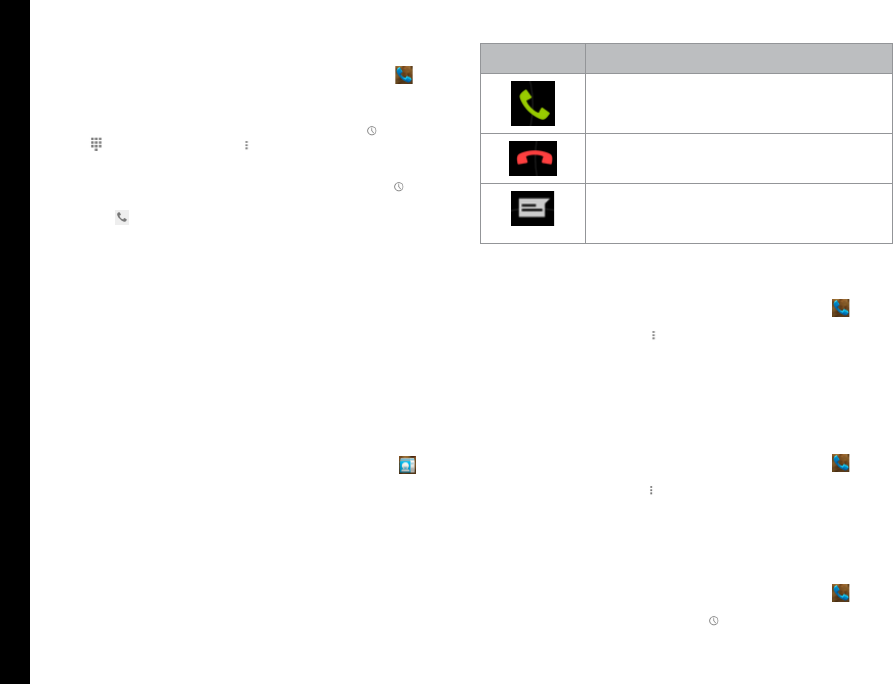
43
Managing Calls
Making a Call
1. From Home or All apps screen, tap Phone ( ).
The Phone screen with last dialled number,
frequently called contacts, Call history ( ), dial pad
( ) and call options ( ) is displayed.
To dial a number use one of the following options:
• Call history: Tap the call history icon ( ). Tap
the contact/number and tap the phone icon (
) located next to the specic phone number/
contact.
• Dial pad: Tap the dial pad. The numeric touch
keypad is displayed. Dial the phone number
and tap the phone icon to make a call.
To dial an international number, prex the phone
number with the respective country code.
• Frequently called contacts/numbers: Tap the
specic contact/number from the frequently
called numbers to make a call.
Dialing a Number via People
1. From Home or All apps screen, tap People ( ).
2. Scroll to the contact and tap the contact. The
contact details are displayed.
3. Tap the required phone number to call the contact.
Answering an Incoming Call
To answer/reject an incoming call, touch the white phone
icon and slide over one of these icons:
Icons Description
Answer the call.
Disconnect the call.
Disconnect the call and respond with a
quick response from a list of response
text messages.
Adding a Contact From Phone Screen
1. From Home or All apps screen, tap Phone ( ).
2. Tap Call options ( ). You can also press the
Options button located about the End call button.
3. Tap New Contact.
4. Enter the contact details and tap Done.
Viewing All Contacts from Phone Screen
1. From Home or All apps screen, tap Phone ( ).
2. Tap call Options ( ). You can also press the
Options button located about the End call button.
3. Tap All Contacts.
Viewing Call History
1. From Home or All apps screen, tap Phone ( ).
2. Tap the Call history icon ( ).

44
Managing Calls
3. Tap All to view all the incoming, outgoing and
missed calls.
4. Tap Missed to view only the missed calls.
Deleting Call History
1. From Home or All apps screen, tap Phone ( ).
2. Tap the Call history icon ( ).
3. Press the Options button located about the End
call button.
4. Tap Clear call log to delete the call history.
Deleting Frequently Called Contacts List
1. From Home or All apps screen, tap Phone ( ).
2. Tap Call options ( ). You can also press the
Options button located about the End call button.
3. Tap Clear Frequents.
Managing Call Settings
You can change the incoming call ring tone, enable
vibrate during call and also activate voice-mail and dial
pad touch tones using call settings.
To view and modify call settings,
1. From Home or All apps screen, tap Phone ( ).
2. Tap Call options ( ). You can also press the
Options button located about the End call button.
3. Tap Settings.
Changing Ringtones
1. In the Call settings screen, tap Phone ringtone.
2. Select the ringtone from the ringtones list and tap
Ok.
Activating Touch Tones
In the Call settings screen, enable Audible touch
tones to activate touch tones when you press a
number on the dial pad.
Activating Vibrate Mode
In the Call settings screen, enable Vibrate when
ringing to receive both ring and vibrate alert for an
incoming call.
Editing Quick Responses
When you are not able to answer an incoming call, you
can send quick response to the caller.
To view and edit quick responses, in the Call settings
screen, tap Quick responses, tap the specic response
message to edit. Edit the message and tap OK.
Managing Fixed Dial Numbers
FDN (xed dialing numbers) is a SIM card-enabled
feature. It restricts outgoing calls only to phone numbers
listed in the FDN list. This feature can be activated only if
PIN2 is entered. Contact your network opreator if you do
not have a PIN2.
Monitoring Incoming and Outgoing Calls

45
Managing Calls
The Call screening options helps you to monitor and
regulate your incoming and outgoing calls.
Screening Outgoing Calls
In the call settings screen, enable Screening outgoing
calls to call only numbers stored in the FDN list.
Turn on proximity sensor
You can save battery power by switching off the display
when you are in a call. Enable Turn on proximity sensor to
switch off the display, when you answer a call.
1. In the call settings screen, enable Proximity sensor.
Setting TTY Mode
If you enable TTY mode, hearing-impaired individuals can
send and receive phone calls as text over the phone.
1. In the call settings screen, tap TTY mode to view
and modify TTY mode settings.
2. Set one of the following options:
• TTY Off: disables TTY mode.
• TTY Full: enables TTY mode for both incoming
and outgoing calls. Set this for both hearing
and voice assistance.
• TTY HCO: enables TTY mode only for incoming
calls. Set this for only hearing assistance.
• TTY VCO: enables TTY mode only for outgoing
calls. Set this for only voice assistance.
Call Forwarding
You can forward your incoming calls to a number in
the contacts or a new number, provided your network
operator supports this service.
To access call forward settings in the call settings screen,
tap Call forwarding. Select one of the following call
forward options:
Options Function
Always
forward
Forward all incoming calls to a pre-
designated number.
Forward when
busy
Forward calls when your phone is
busy.
Forward when
unanswered
Forward calls when you do not
answer incoming calls.
Forward when
unreachable
Forward calls when your phone is
switched off or is out of coverage
area.
Call Waiting
When call waiting is enabled and the phone is in
conversation, the incoming number is displayed when
you receive a call.
To activate call waiting in the call settings screen, tap
Additional settings. Enable Call waiting.
Internet Call Settings
You can make calls and receive calls over Internet when
connected to Wi-Fi network, rather than over your mobile
network.

46
Managing Calls
To place a call over Internet, phone must be congured to
use an Internet calling account.
After you set up the account, placing an Internet call is
not different than placing any other call. However, you
must be connected to a Wi-Fi network. When you are
making an Internet call, the phone displays Internet Call
near the top of the screen.
SIP Accounts
Internet calling is based on the Session Initiation Protocol
(SIP) for voice calls on Internet Protocol (IP) network.
To add a SIP account and congure your incoming and
outgoing preferences:
1. In the call settings screen, tap SIP Accounts.
2. Enable Receive incoming calls, to answer
incoming Internet calls.
This might reduce your phone’s battery life.
3. Tap Add account, to congure a new SIP account.
4. Enter the following details and tap Save.
• Username: Username to login to SIP account.
• Password: Password to login to SIP account.
• Server: SIP server details.
• Set as primary account: Enable to set this SIP
account as the primary account.
• Optional Settings: Tap to view/modify or
hide optional details such as authentication
username, display name, outbound proxy
address, port number, transport type and Send
keep alive options.
Use Internet Calling
1. In the call settings screen, tap Use Internet Calling
located under Internet call Settings.
2. Select one of the following options:
• For all calls when data network is available:
If this option is selected and when the phone is
connected to Wi-Fi network or mobile Internet,
each dialed call becomes an Internet call.
• Only for Internet calls: If this option is
selected, only Internet call can be dialed.
• Ask for each call: If this option is selected,
when a number is selected to dial, a dialog is
displayed to select either Cell phone call or
Internet call.
Optimizing Power During a Call
You can save battery power by switching off the display
when you are in a call. Enable Turn on proximity sensor
to switch off the display, when you answer a call.

47
Managing Calls
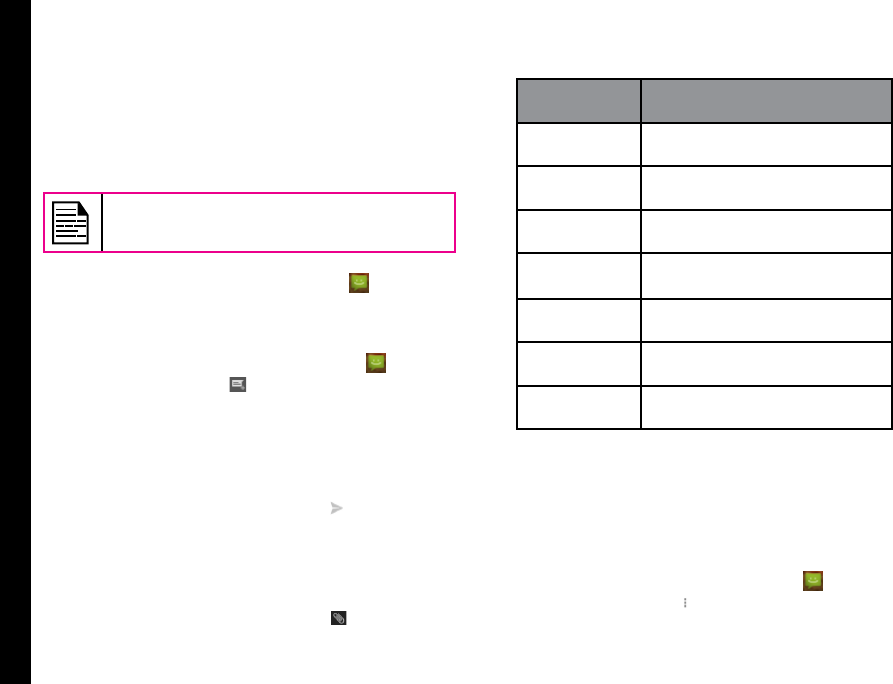
48
Sending Messages
SMS and MMS are convenient and inexpensive means
of communication. You can send a text message to
other people via SMS service. MMS allows you to send
messages by including multimedia content such as
pictures, audio les, video les, and so on.
You can use the Messages in your phone to send an
SMS and MMS message to other mobile phones or any
other equipment that can receive SMS and MMS.
The MMS feature is available only if you
subscribe it from your network operator.
To access the messages function, from the home screen
or All applications screen, tap Messages ( ).
Sending SMS/MMS Message
1. To create a SMS message, from the home screen or
All applications screen, tap Messages ( ).
2. Tap New message ( ).
3. Enter the contact name or the phone number in the
To eld.
If you enter an alphabet, all the contact names
starting with that alphabet is displayed as a list.
Scroll down to select the contact.
4. Enter the message and tap Send ( ).
When you add a multimedia attachment, the
message is automatically converted to a multimedia
message. MMS charges are applied based on the
operator.
5. To add an attachment, tap Attach ( ). Select the
attachment type from the following options:
6. Browse My les or specic folder and select the
multimedia le to be attached.
Attachment
Type
Description
Pictures Attach a photo from the phone
memory.
Capture
picture
Take a new photo using the
mobile camera and attach.
Videos Attach a video from the phone
memory.
Capture
Video
Take a new photo using the
mobile camera and attach.
Audio Attach an audio le from the
phone memory.
Record audio Record a new audio le using
the voice recorder and attach.
Slideshow Create new slideshow or edit the
existing slides and attach.
Managing Message Settings
You can customize the way you want to view and lter
the messages. You can also set the default messaging
application.
To view and modify the message settings,
1. To edit message settings, from the home screen or
All applications screen, tap Messages ( ).
2. Tap message options ( ). You can also press the
Options button located about the End call button.
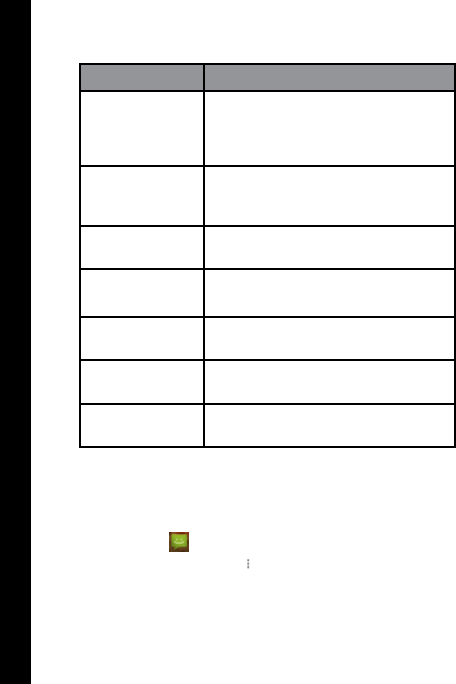
49
3. View and edit the following settings:
Settings Description
SMS enabled Set the default messaging
application.
Delete old
messages
Delete the old messages
automatically when the storage
limit is reached.
Text message
limit
Set the maximum number of
SMS messages to be stored.
Multimedia
message limit
Set the maximum number of
MMS messages to be stored.
Notification Enable notication alert for
incoming messages
Sound Set the default alert tone for
incoming messages
Vibrate Enable vibrate alert for incoming
messages
Deleting Messages
To delete all the message threads,
1. From the home screen or All applications screen, tap
Messages ( ).
2. Tap message options ( ). You can also press the
Options button located about the End call button.
3. Tap Delete all threads. All the message thread are
deleted after conrmation.
Cell Broadcast Messages
You receive active alerts and emergency alerts from the
service provider.
Managing Messages

50
You can view and modify the keyboard, language and
dictionary setting using the Phone Settings. For more
information, refer “Google Play Store” on page 51.
Text Entry Options
When you enter the text message, you can change the
text entry options by pressing the # key. The current text
entry options is displayed in the top bar.
The various text entry options are
• ABC: Enter all the text in capital letters.
• Abc: Enter the rst letter of the paragraph in capital
letters.
• abc: Enter all the text in small letters.
• 123: Enter the numbers.
• T9EN: Enter the text based on the T9 dictionary. All
the letters is in upper case (capitalized).
• T9En: Enter the text based on the T9 dictionary.
Only the rst letter of the paragraph is in upper case
(capitalized).
• T9en: Enter the text based on the T9 dictionary. All
the letters are in lower case.
Using the Keyboard

51
Google Play Store
Google Play store is a one stop application to access all
your favorite media content such as games, TV shows,
books, music, magazines, and much more.
Downloading Android Applications and Media Files
You can download and install/view your android
applications/media les, when your phone is connected
to the Internet through Wi-Fi or mobile data connection.
You can also download les from Gmail or other sources.
To manage application downloads, tap the Downloads
icon ( ) located on the All Apps screen. Downloaded
movies and other media les are not listed in the
Downloads screen.
Use the Downloads screen to view, reopen, or delete the
downloaded les.
• Tap the le to open it.
• Touch headings for earlier downloads to view them.
• Check items you want to share. Then touch the
Share icon and choose a sharing method from the
list.
• Check items you want to delete. Then touch the
Trash icon.
• At the top of the screen, touch the 3 horizontal lines
to sort your downloads by name, by date modied,
or by size.
Accessing GMail
Gmail application is used to read and write e-mail form
any mobile device.
Gmail account can be used to sign in to all Google
applications and services which includes;
• Google now - Locate the right information at the
right time.
• Calendar - View, add and sync the calendar events
with the phone
• People - View, add and sync contacts stored in the
phone
• Google Drive - Access documents on the go.
While reading a message,
• Touch the icons and menus along the top of the
screen to archive, label or perform other actions on
that message.
• Swipe left or right to delete the message and undo
the action.
Camera
The Sonim XP6 has a back camera with 5MP xed focus
for taking pictures. The pictures are saved in Gallery (
) in your phone memory. You can access gallery from All
Apps screen.
• To take a picture, press the Camera button (yellow
button located on the left side of your phone) or
tap the Camera icon ( ) present in the All Apps
screen.
The camera screen with touch controls ( )
is displayed.
• Tap Camera mode ( ), to set one of the
following modes :
• Normal - ( ) : To shoot a picture in normal
Installing and Using Android Applications

52
mode. Tap the Capture icon ( ) to capture
the picture. You can touch & hold, then slide to
zoom in and out, to take a clear picture.
• Video - ( ): To shoot a video. Tap the
Record icon ( ) to shoot the video. Tap
the Stop icon ( ) to end the recording. You
cannot pause the recording in the middle.
• Panoramic ( ): To shoot a picture in
panoramic view. Tap the Capture icon ( )
to capture the picture. Start from the left most
edge of the image and move towards the right
most edge to capture the complete panaromic
image.
• To view or change camera settings such as ash,
exposure, and le size, tap the Settings icon ( )
located to the right of the shutter.
Calendar
The calendar helps you to set appointments, schedule
reminders and alerts and repeat them if required. You can
also view your saved tasks on a daily or weekly basis.
When you rst set up your phone and congure it to use
a Google Account (such as Gmail), you can link your
Google calendar also. All the appoinments and tasks
stored in the Google calendar will also be synced to your
phone.
To access calendar,
1. Tap Calendar icon ( )on the All Apps screen.
2. To change the calendar view, choose Day, Week,
Month, Agenda from the top of the screen in a drop-
down list.
3. Select Options (RSK) button to view the list of
following available options:
• Today: Access current date events.
• New event: When Google calendar is synced
with you Google account, new event can be
added using the Google account.
• Refresh: Refresh the calendar for the updates.
• Search: You can search for a particular event.
• Calendar to display: Displays the calendar
which is synced with your Google account.
• Settings: Displays the General settings of the
calendar.
From any of the calendar views,
• Read or edit event details: Tap on the event to
view the details.
• Manage events and calendar: Touch icons across
the top of the screen or the menu to search or create
events, return to today, or adjust settings.
Alarm
You can set an alarm for a particular time.
1. Tap the Clock icon ( ) located in the All Apps
screen.
2. Tap the Alarm activation icon ( ) on the top of the
screen.
• To set a simple alarm, tap Add Alarm ( )
icon. Enter the time and tap Done.
• To set a reoccuring alarm, enable Repeat.
Select the days for repeating the alarm.
Installing and Using Android Applications
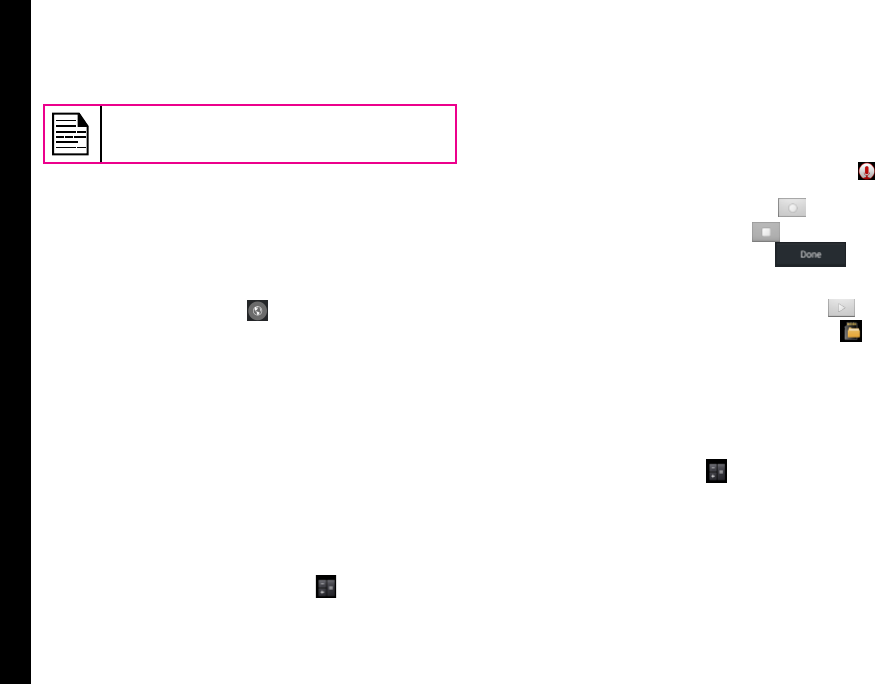
53
• To set the alarm tone, select the type of
alarm from the Ringtone list. Tap the selected
ringtone and select OK.
The alarm will work even when the phone is set
in silent mode.
Clock
You can view the time of major cities in different time
zones using this function. You also have the option to use
Daylight Saving Time (DST).
• The local time in the home city is displayed in the
upper half of the screen.
• Tap World clock icon ( ) located at the botton of
the screen, to view the list of cities and the current
time.
The world cities are listed in the alphabetical
order.
• To set the home city, tap the required city from
the list. It is added to the Selected Cities list. The
selected city is set as the home city and the current
time is changed accordingly.
Calculator
The default calculator in this phone is designed to
perform simple mathematical calculations. press Options
(RSK) to perform advanced calculations.
To access calculator, tap Calculator ( ) located in All
Apps screen.
• To enter the numbers, tap the numeric keys.
• To use mathematical operators, touch the respective
operation keys on the keypad.
• Tap = for the nal results.
Sound Recorder
You can record voice memos using the sound recorder.
To access the sound recorder, tap Sound recorder ( )
located in All Apps screen.
• To record an audio le, tap Record ( ).
• To stop the recording, tap Stop ( ).
• To save the voice memo, tap Save ( ).
• To exit without saving, select Optionsand Discard.
• To play the recorded le instantly tap Play ( ).
The recorded les are stored in the File explorer ( ).
You can access le explorer from the All Apps screen.
Music Player
You can play music les and voice memos stored in your
phone using the music application. The music les are by
default stored in the music folder in File explorer.
To play music les, tap Music ( ) located in All Apps
screen.
• Tap Playlist to access the default playlists in the
music folder.
• Tap Recently Added playlist to view the music les
that are recently added to the music folder.
• Tap My recordings playlist to access all your voice
memo les.
Installing and Using Android Applications

54
• Tap Artist to view the music les sorted based on
the artists.
• Tap Album to view the music les sorted based on
the albums.
• Tap Songs to view the complete list of songs stored
in your phone.
• Tap the required song/memo to play.
Installing and Using Android Applications

55
End User License Agreement
Our Warranty
This wireless device, (the “Device”) contains software
owned by Sonim Technologies, Inc. (“Sonim”) and its
third party suppliers and licensors (collectively, the
“Software”). As user of this Device, Sonim grants you a
non- exclusive, non-transferable, non-assignable license
to use the software solely in conjunction with the Device
on which it is installed and/or delivered with. Nothing
herein shall be construed as a sale of the Software to a
user of this Device.
You shall not reproduce, modify, distribute, reverse
engineer, decompile, otherwise alter or use any other
means to discover the source code of the Software
or any component of the Software. For avoidance of
doubt, you are at all times entitled to transfer all rights
and obligations to the Software to a third party, solely
together with the Device with which you received the
Software, provided always that such third party agrees in
writing to be bound by these rules.
You are granted this license for a term of the life of this
Device. If you fail to comply with any of the terms and
conditions set out in this license, it terminates with
immediate effect. Sonim and its third party suppliers and
licensors are the sole and exclusive owner of and retain
all rights, title and interest in and to the Software. Sonim,
and, to the extent that the Software contains material or
code of a third party, such third party shall be entitled
third party beneciaries of these terms. The validity,
construction and performance of this license shall be
governed by the laws of Delaware, United States.
Comprehensive 3 Year Warranty
Sonim provides this Comprehensive three-year warranty
for your mobile phone (hereinafter referred to as
“Product”).
You may register your phone at www.sonimtech.com/
register to receive further information about your product.
Should your Product need service, please contact Sonim
customer support.
Our Warranty
Subject to the conditions of this Comprehensive 3-year
Warranty, Sonim warrants this product to be free from
major defects in design, material and workmanship at
the time of its original purchase by a consumer, and for a
subsequent period of three (3) years.
What We Will Do
If during the warranty period, this product fails to operate
in accordance with its specications under normal
use and service, due to defects in design, material or
workmanship, Sonim’s authorized distributors or service
partners, in the country/region where you purchased
the product, will repair or replace at the sole discretion
of Sonim, with the same or better model in the same or
better condition as detailed below:
1. If a device is out-of-warranty, then additional repair
charges may apply;
2. You will be advised of the charges in advance of any
work being performed;
3. You will have the option to approve the charges and
have the repair performed, or you may choose to
have your device returned to you unrepaired;
4. Any repair charges will be billed to you through
Sonim’s Authorized Distributor.
Please note that some of your personal settings,

56
End User License Agreement
downloads or other information may be lost when your
Sonim Product is repaired or replaced. Sonim does not
take any responsibility for any lost information of any kind
and will not reimburse you for any such loss.
You should always make backup copies of all the
information stored on your Sonim Product such as
downloads, calendar and contacts before handing in your
Sonim Product for repair or replacement.
Phone Care
Each Sonim phone has a designated IP class for dust and
water protection, according to the IEC Ingress Protection
(IP) Standard 60529. This means that the phone is dust
protected and can be submerged into 2 m deep water for
up to 60 minutes. Immersion in deeper water can damage
it and must be avoided.
Sonim phones are solid and built for heavy duty use.
Its design protects against disassembly or mechanical
damage when subjected to forces equal to free fall from
the height of 2 meters. Subjecting the phone to stronger
impact and forces can damage it and must be avoided.
Conditions
1. The warranty is valid whether or not the product has
been registered.
2. The warranty is valid only if the original proof of
purchase issued to the original purchaser by an
authorized service provider, specifying the date
of purchase and serial number for this Product,
is presented with the Product to be repaired
or replaced. Sonim reserves the right to refuse
warranty service if the device is found to be out of
warranty under the conditions as set forth herein.
3. If Sonim repairs or replaces the Product, the
repaired or replaced Product shall be warranted
for the remaining time of the original warranty
period or for ninety (90) days from the date of
repair, whichever is longer. Repair or replacement
may involve the use of functionally equivalent
reconditioned units. Replaced parts or components
will become the property of Sonim.
4. This warranty does not cover any failure of the
Product due to normal wear and tear, or due to
misuse or abuse, including but not limited to use
in other than the normal and customary manner, in
accordance with the Sonim device specications
and instructions for use and maintenance of
the Product. Nor does this warranty cover any
failure of the Product due to software or hardware
modication or adjustment, acts of God or damage
resulting from liquid interacting with the product
beyond what is described as acceptable in the
user guide for the product. A rechargeable battery
can be charged and discharged hundreds of times.
However, it will eventually wear out - this is not
a defect. When the talk-time or standby time is
noticeably shorter, it is time to replace your battery.
Sonim recommends that you use only batteries and
chargers approved by Sonim. Minor variations in
display brightness and color may occur between
phones. There may be tiny bright or dark dots on
the display. These are called defective pixels and
occur when individual dots have malfunctioned and
cannot be adjusted. Up to three defective pixels are
deemed acceptable.
5. This warranty does not cover Product failures
caused by installations, modications, or repair or
opening of the Product performed by a any person
other than a Sonim-authorized person. Tampering

57
End User License Agreement
with any of the seals on the Product will void the
warranty.
6. The warranty does not cover Product failures which
have been caused by use of accessories or other
peripheral devices which are not Sonim-branded
original accessories intended for use with the
Product.
7. The 3-year warranty does not cover 3rd party
accessories or any 3rd party software applications,
which are instead covered to the extent provided by
the original vendor guarantee for these products.
8. THERE ARE NO EXPRESS WARRANTIES,
WHETHER WRITTEN OR ORAL, OTHER THAN
THIS PRINTED LIMITED WARRANTY. ALL
IMPLIED WARRANTIES, INCLUDING WITHOUT
LIMITATION THE IMPLIED WARRANTIES OF
MERCHANTABILITY OR FITNESS FOR A
PARTICULAR PURPOSE, ARE LIMITED TO THE
DURATION OF THIS LIMITED WARRANTY. IN NO
EVENT SHALL SONIM OR ITS LICENSORS BE
LIABLE FOR INCIDENTAL OR CONSEQUENTIAL
DAMAGES OF ANY NATURE WHATSOEVER,
INCLUDING BUT NOT LIMITED TO LOST PROFITS
OR COMMERCIAL LOSS; TO THE FULL EXTENT
THOSE DAMAGES CAN BE DISCLAIMED BY LAW.

58
Federal Communication Commission Interference (FCC) Statement
WARNING: Changes or modications made to
this equipment not expressly approved by Sonim
Technologies, Inc. for compliance could void the user’s
authority to operate the equipment.
FCC Statement
• This device complies with part 15 of the FCC rules
(FCC ID: WYPL11V011AA). Operation is subject to
the following two conditions:
• This device may not cause harmful interference.
• This device must accept any interference
received, including interference that may cause
undesired operation.
• This device has been tested and found to comply
with the limits for a Class B digital device, pursuant
to Part 15 of the FCC Rules. These limits are
designed to provide reasonable protection against
harmful interference in a residential installation. This
equipment generates, uses, and can radiate radio
frequency energy, and, if not installed and used in
accordance with the instructions, may cause harmful
interference to radio communications. However,
there is no guarantee that interference will not occur
in a particular installation If this equipment does
cause harmful interference to radio or television
reception, which can be determined by turning the
equipment off and on, the user is encouraged to
try to correct the interference by one or more of the
following measures:
• Reorient or relocate the receiving antenna.
• Increase the separation between the equipment
and receiver.
• Connect the equipment into an outlet on a
circuit different from that to which the receiver
is connected.
• Consult the dealer or an experienced radio/TV
technician for help.
FCC Caution
Any Changes or modications not expressly approved
by the party responsible for compliance could void the
user‘s authority to operate the equipment.
The antenna(s) used for this transmitter must not be
co-located or operating in conjunction with any other
antenna or transmitter.

59
Règlement FCC
AVERTISSEMENT: toute modication apportée à cet
appareil sans l’accord exprès de conformité de Sonim
Technologies, Inc. peut annuler l’autorisation d’utilisation
accordée initialement pour cet appareil.
Règlement FCC
Cet appareil XP6700 est conforme à l’article 15 du
règlement FCC (FCC ID: WYPL11V011AA). Son
utilisation est sujette aux deux conditions suivantes:
• Cet appareil ne doit provoquer aucune
interférence nuisible.
• Cet appareil doit accepter toutes
les interférences reçues, y compris
celles susceptibles d’entraver son bon
fonctionnement.
Cet équipement a été testé et s’est avéré conforme aux
limites dénies dans l’article 15 du règlement FCC pour
un équipement numérique de classe B. Ces limites ont
été choisies an d’assurer une protection raisonnable
contre les interférences nuisibles dans un environnement
résidentiel. Cet équipement génère, utilise et peut émettre
des énergies de fréquence radio, et, s’il n’est pas installé
et utilisé conformément au guide d’utilisateur, perturber
les communications radio. Nous ne garantissons pas
l’absence de toute interférence dans une installation
privée. Si cet équipement s’avère perturber la bonne
réception de la radio ou de la télévision, ce qui peut
facilement être vérié en allumant puis éteignant
l’équipement, nous encourageons l’utilisateur à essayer
d’éliminer ces interférences à l’aide des conseils
suivants:
• Réorientez ou déplacez l’antenne réceptrice.
• Augmentez la distance séparant l’équipement
du récepteur.
• Branchez l’équipement sur une autre ligne
électrique que celle utilisée pour le récepteur.
• Demandez conseil à votre revendeur ou à un
technicien radio/TV compétent.
FCC Précaution
Tous changements ou modications non expressément
approuvés par la partie responsable de la conformité
pourraient annuler l’autorité de l’utilisateur à utiliser
l’équipement.
L’antenne (s) utilisé pour cet émetteur ne doit pas être
co-localisées ou opérant en conjonction avec une autre
antenne ou émetteur.
Règlement IC
Le présent appareil est conforme aux CNR d’Industrie
Canada applicables aux appareils radio exempts de
licence (IC ID: 8090A-L12V011AA). L’exploitation est
autorisée aux deux conditions suivantes:
1. L’appareil ne doit pas produire de brouillage, et
2. L’utilisateur de l’appareil doit accepter tout
brouillage radioélectrique subi, même si le
brouillage est susceptible d’en compromettre le
fonctionnement.
Cet appareil numérique de la classe B est conforme à la
norme NMB-003 du Canada.
FOR PORTABLE DEVICE USAGE (<20cm from body/SAR needed)
Déclaration d’exposition aux radiations:

60
Federal Communication Commission Interference (FCC) Statement
Le produit est conforme aux limites d’exposition pour les
appareils portables RF pour les Etats-Unis et le Canada
établies pour un environnement non contrôlé.
Le produit est sûr pour un fonctionnement tel que décrit
dans ce manuel. La réduction aux expositions RF peut
être augmentée si l’appareil peut être conservé aussi loin
que possible du corps de l’utilisateur ou que le dispositif
est réglé sur la puissance de sortie la plus faible si une
telle fonction est disponible.
FOR MOBILE DEVICE USAGE (>20cm/low power)
Déclaration d’exposition aux radiations:
Cet équipement est conforme aux limites d’exposition
aux rayonnements IC établies pour un environnement non
contrôlé. Cet équipement doit être installé et utilisé avec
un minimum de 20 cm de distance entre la source de
rayonnement et votre corps.
Cet appareil et son antenne ne doivent pas être situés ou
fonctionner en conjonction avec une autre antenne ou un
autre émetteur, exception faites des radios intégrées qui
ont été testées. La fonction de sélection de l’indicatif du
pays est désactivée pour les produits commercialisés aux
États-Unis et au Canada.
• les appareils opérant sur la bande 5150-5250
MHz sont conçus uniquement pour une utilisation
intérieure an de minimiser les risques de brouillage
dans le même canal que les systèmes de services
par satellite;
• les radars de grande puissance sont désignés
comme utilisateurs primaires (et ont donc priorité
d’utilisation) sur la bande 5250 - 5350 MHz et
5650-5850 et de tels radars peuvent causer des
interférences et/ou endommager des appareils
LE-LAN.

61
A
Adding a contact from phone
screen 42
Add new contact 39
Airplane mode 32
Alarm 51
All applications icon 19
Android security 34
Answering a call 42
Application/media le download
50
Audible touch tones 43
B
Backup data 36
Battery
Charging indicator 13
Battery usage 13
Charging 13
Improving battery life 14
Optimize power 13
Bluetooth devices 30
Editing Bluetooth device settings
31
Pairing a Bluetooth device 31
Bluetooth tethering 32
Broadcast messages 48
C
Calculator 52
Calendar 51
Call accept/Send key 17
Calling from People 39
Call monitoring 43
Call settings 43
Call waiting 44
Camera 28, 50
Cell boradcast messages 33
Changing wallpaper 22
Clock 52
Connecting a PC using USB
connection 28
Connecting to a Wi-Fi network
Adding a new network 30
Editing a Wi-Fi network 30
Forgetting a Wi-Fi network 30
WPS for router 30
Connecting to a wireless device
28
Connecting to Wi-Fi network 30
Contacts
Add 39
Send message 39
Credential certicates 35
D
Data backup and restore 36
Data syncing 37
Adding an account 37
Conguring an account 37
Manual 37
Sync contacts to Google account
41
Deleting a contact 41
Deleting call history 43
Deleting messages 48
Device details 29
Dialing a call 42
From People 42
Display icons 19
Display settings 27
Wallpaper 22
E
Editing contact details 39
Events 51
Exporting contacts to computer
40
Exporting contacts to SIM card 40
F
Favorites tray 19
Fixed dial numbers (FDN) 43
Index

62
Force stopping an application 28
Frequenctly called list 43
G
Gmail 50
Google account 18, 36
Adding an account 36
Deleting an account 36
Syncing data 37
Google search bar 20
H
HAC rating 10
Harmful applications 35
Home screen 19
Indicators 20
Home screen icons/folders
Adding to home screen 20
Creating in home screen 20
Moving an icon/folder 20
Removing from home screen 20
I
Importing contacts to phone 39
Internet calls 44, 45
K
Keypad
Accept/Send 24
Back 24
End call 24
Navigation keys 24
Power On/Off 24
Keypad for Sonim XP6 17
Keypad functions 24
Keypad layout
Xp6 phone 17
L
Language settings 26
Personal dictionary 26
Speech 26
Spell checker 26
Location access 36
M
Managing memory utilized by
applications 29
Media device 28
MMS 47
Sending MMS message 47
Mobile network 32
Mouse/pointer settings 27
Music player 52
O
Optimizing data usage 31
Optimizing memory usage 29
Optimizing power 27, 45
P
People 39
People/Contact settings 41
Phone data encryption 34
Phonelock screen 22
Phone protection 35
Phone specications 15
Play store 50
Power Optimization 13
Power saving settings 27
Force stopping an application 28
Viewing battery life 27
Proximity sensor 44
Q
Quick responses 43
R
Restore data 36
Ringtones 43
S
Safety Guidelines for mobile usage
8
SAR information 10
Index

63
Screen lock 34
Search bar 20
Searching Contacts/people 41
Security settings 34
Phonelock screen 22
Sending SMS 47
Sending SMS/MMS
From People 39
Setting up your phone 18
Sharing contact details 40
SIM card 15
Inserting SIM card 16
SIM card lock 35
SIP accounts 45
SMS 47
SMS settings 47
Sound recorder 52
System icons 20
T
Tethering and portable hotspot 32
Text entry 49
Time and date settings 26
Touch and type operations 18
TTY mode 44
V
vibrate mode 43
Viewing call history 42
Viewing contact details 39
Viewing contacts from phone
screen 42
Viewing device details 29
Voice recorder 52
W
Wi-Fi hotspot 32
WPS for router 30
X
XP6 phone
Box contents 15
Keypad layout 17
Switching On 18
Index

